Paul van Yperen's Blog, page 350
April 1, 2016
Marianne Krencsey (1931-2016)
Last Wednesday, 30 March 2016, Hungarian Actress Marianne Krencsey died. She starred in some of the classics of the Hungarian cinema like her debut film Liliomfi/Lily Boy (Karoly Makk, 1954), Bolond április/Summer Clouds (Zoltán Fábri, 1957) and Fapados szerelem/Discount love (Félix Máriássy, 1960). Marianne Krencsey stopped making films in 1966 after she left Hungary. She passed away in New York, at the age of 84.
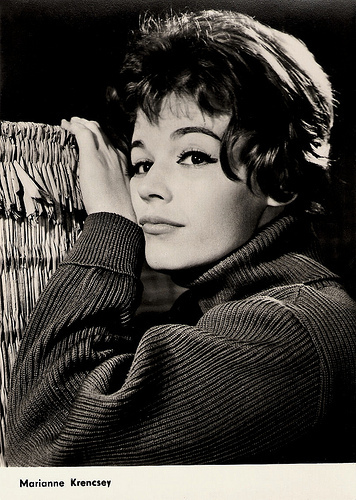
East-German postcard by VEB Progress Filmvertrieb, Berlin. no. 1707, 1962. Photo: Hungarofilm.
Lily Boy
Marianne Krencsey was born in Rákoscsaba (now Budapest), Hungary in 1931. Her parents were Vilmos Krencsey and Anna Lackner. Her father was from an old noble family.
Krencsey attended the Peter Pázmány University and studied acting and directing. In Budapest she met director Karoly Makk who offered her the female lead role opposite Iván Darvas in his film Liliomfi/Lily Boy (1954). The film was show at the 1955 Cannes Film Festival, but did not win an award.
She also appeared in Makk’s A 9-es kórterem/The 9-ward (Karoly Makk, 1955). Krencsey married Karoly Makk in 1957, but the couple divorced in 1960.
In 1955, the Hungarian Television began to make test broadcasts with her. In the following years, she also appeared in several Hungarian films including Gábor diák/The Gabor students (László Kalmár, 1956) with Ferenc Zenthe, the crime drama Két vallomás/Two Wishes (Márton Keleti, 1957) starring Mari Töröcsik , Bolond április/Summer Clouds (Zoltán Fábri, 1957), and Szegény gazdagok/Poor Rich (Frigyes Bán, 1959) with Gyula Benkö and Margit Bara .
Krencsey also had a supporting part in the French-Hungarian coproduction La belle et le tzigane/The beauty and the gypsy (Jean Dréville, Márton Keleti, 1959) featuring Nicole Courcel and Gyula Buss.
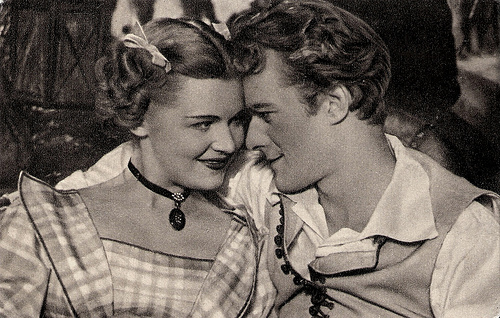
Hungarian postcard by Képzömüvészeti Alap Kiadóvállalata, Budapest, no. 331/9/571. Photo: Hungarofilm. Publicity still for Liliomfi/Lily Boy (Karoly Makk, 1954) with Iván Darvas.
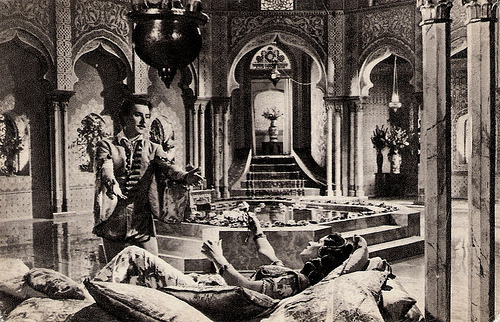
Hungarian postcard by Képzömüvészeti Alap Kiadóvállalata, Budapest, no. 331/9/571. Photo: publicity still for Gábor diák/Gabor students (László Kalmár, 1956) with Ferenc Zenthe.
Evil role
Marianne Krencsey also worked as an actress and director for the theatre. She was engaged by the Kecskemét Katona József Theatre, the Comedy Theatre, the Szolnok Szigliget Theatre and the National Theatre of Pécs.
In the cinema she was seen in the romantic comedy Két emelet boldogság/Two floors of happiness (János Herskó, 1960) with Edit Domján, Fapados szerelem/Discount love (Félix Máriássy, 1960), in which she was reunited with Ferenc Zenthe, and A Noszty fiú esete Tóth Marival/Young Noszty and Mary Toth (Viktor Gertler, 1960).
She also appeared for the first time in an evil role in the still popular historical drama Az aranyember/The Man of Gold (Viktor Gertler, 1962). This was a film adaptation of Mór Jókai's classic 19th century novel on Mihály Tímár, the captain of a commercial Danube ship in the 1830s.
In 1962, Marianne Krencsey remarried Gyula Nemes, a doctor-gynaecologist. She played the female lead in Meztelen diplomata/The naked diplomat (György Palásthy, 1963) and had a small part in the international coproduction Germinal (Yves Allégret, 1963) with Jean Sorel .
Her last films were A Tenkes kapitánya/The Captain from Tenkes (Tamás Fejér, 1965) and A férfi egészen más/The man is quite different (Tamás Fejér, 1966).
In 1966, Marianne and her husband left Hungary for political reasons. They travelled along London and Reykjavik to the United States and settled there permanently. The former film star worked there as a bank clerk and later in her husband's doctor's office for twenty years. In 1971 the couple received US citizenship. In 2001, she published an auto-biography. Marianne Krencsey had a son, Vincent Nemes, and a grandson.
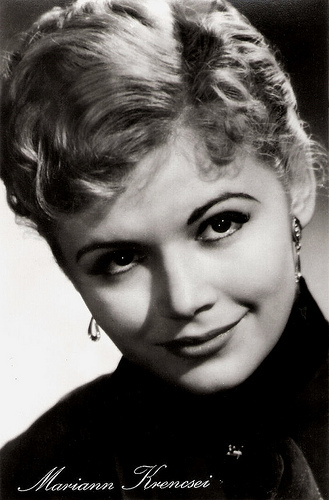
East-German postcard by VEB Progress Filmvertrieb, Berlin. no. 634, 1958. Photo: Magyar-Film.
Sources: Origo (Hungarian), Wikipedia (Hungarian), and .

East-German postcard by VEB Progress Filmvertrieb, Berlin. no. 1707, 1962. Photo: Hungarofilm.
Lily Boy
Marianne Krencsey was born in Rákoscsaba (now Budapest), Hungary in 1931. Her parents were Vilmos Krencsey and Anna Lackner. Her father was from an old noble family.
Krencsey attended the Peter Pázmány University and studied acting and directing. In Budapest she met director Karoly Makk who offered her the female lead role opposite Iván Darvas in his film Liliomfi/Lily Boy (1954). The film was show at the 1955 Cannes Film Festival, but did not win an award.
She also appeared in Makk’s A 9-es kórterem/The 9-ward (Karoly Makk, 1955). Krencsey married Karoly Makk in 1957, but the couple divorced in 1960.
In 1955, the Hungarian Television began to make test broadcasts with her. In the following years, she also appeared in several Hungarian films including Gábor diák/The Gabor students (László Kalmár, 1956) with Ferenc Zenthe, the crime drama Két vallomás/Two Wishes (Márton Keleti, 1957) starring Mari Töröcsik , Bolond április/Summer Clouds (Zoltán Fábri, 1957), and Szegény gazdagok/Poor Rich (Frigyes Bán, 1959) with Gyula Benkö and Margit Bara .
Krencsey also had a supporting part in the French-Hungarian coproduction La belle et le tzigane/The beauty and the gypsy (Jean Dréville, Márton Keleti, 1959) featuring Nicole Courcel and Gyula Buss.

Hungarian postcard by Képzömüvészeti Alap Kiadóvállalata, Budapest, no. 331/9/571. Photo: Hungarofilm. Publicity still for Liliomfi/Lily Boy (Karoly Makk, 1954) with Iván Darvas.

Hungarian postcard by Képzömüvészeti Alap Kiadóvállalata, Budapest, no. 331/9/571. Photo: publicity still for Gábor diák/Gabor students (László Kalmár, 1956) with Ferenc Zenthe.
Evil role
Marianne Krencsey also worked as an actress and director for the theatre. She was engaged by the Kecskemét Katona József Theatre, the Comedy Theatre, the Szolnok Szigliget Theatre and the National Theatre of Pécs.
In the cinema she was seen in the romantic comedy Két emelet boldogság/Two floors of happiness (János Herskó, 1960) with Edit Domján, Fapados szerelem/Discount love (Félix Máriássy, 1960), in which she was reunited with Ferenc Zenthe, and A Noszty fiú esete Tóth Marival/Young Noszty and Mary Toth (Viktor Gertler, 1960).
She also appeared for the first time in an evil role in the still popular historical drama Az aranyember/The Man of Gold (Viktor Gertler, 1962). This was a film adaptation of Mór Jókai's classic 19th century novel on Mihály Tímár, the captain of a commercial Danube ship in the 1830s.
In 1962, Marianne Krencsey remarried Gyula Nemes, a doctor-gynaecologist. She played the female lead in Meztelen diplomata/The naked diplomat (György Palásthy, 1963) and had a small part in the international coproduction Germinal (Yves Allégret, 1963) with Jean Sorel .
Her last films were A Tenkes kapitánya/The Captain from Tenkes (Tamás Fejér, 1965) and A férfi egészen más/The man is quite different (Tamás Fejér, 1966).
In 1966, Marianne and her husband left Hungary for political reasons. They travelled along London and Reykjavik to the United States and settled there permanently. The former film star worked there as a bank clerk and later in her husband's doctor's office for twenty years. In 1971 the couple received US citizenship. In 2001, she published an auto-biography. Marianne Krencsey had a son, Vincent Nemes, and a grandson.

East-German postcard by VEB Progress Filmvertrieb, Berlin. no. 634, 1958. Photo: Magyar-Film.
Sources: Origo (Hungarian), Wikipedia (Hungarian), and .
Published on April 01, 2016 22:00
March 31, 2016
EFSP's Dazzling Dozen: Stars on Cigarette Cards
Last Friday, EFSP presented you a dozen cigarette cards, made by Ross Verlag in Berlin. These were all cards from a series called Bunte Filmbilder (Colourful Film Pictures). Before that Ross published a series of 275 cigarette cards called 'Unsere Bunte Filmbilder' (Our Colourful Film Pictures) for the Cigarettenfabrik (cigarette factory) Josetti in Berlin, approximately produced in 1935. The cards were enclosed in 'the packs of Josetti's various brands of cigarettes, like Juno and Vera Gold. This series contained smaller cards (6, 5 x 4 cm or 2.5 x 2 inch) with hand coloured portraits. Here are my twelve favourites of this series to make you dazzle.
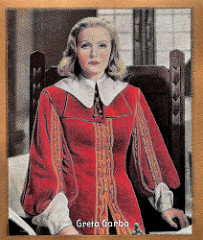
Greta Garbo . German cigarette card in the series Unsere Bunten Filmbilder by Ross Verlag for Cigarettenfabrik Josetti, Berlin, no. 23. Photo: Metro-Goldwyn-Mayer. Publicity still for Queen Christina (Rouben Mamoulian, 1933).
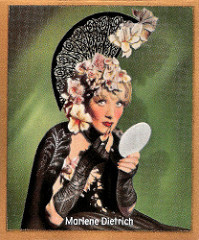
Marlene Dietrich . German cigarette card in the series Unsere Bunten Filmbilder by Ross Verlag for Cigarettenfabrik Josetti, Berlin, no. 25. Photo: Paramount. Publicity still for The Devil is a Woman (Josef von Sternberg, 1935).
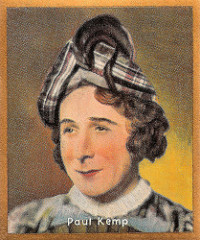
Paul Kemp . German cigarette card in the series Unsere Bunten Filmbilder by Ross Verlag for Cigarettenfabrik Josetti, Berlin, no. 99. Photo: Minerva-Tonfilm.
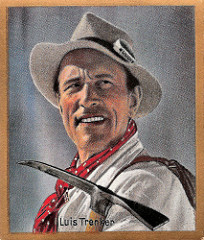
Luis Trenker . German cigarette card in the series Unsere Bunten Filmbilder by Ross Verlag for Cigarettenfabrik Josetti, Berlin, no. 107. Photo: Rota-Film.
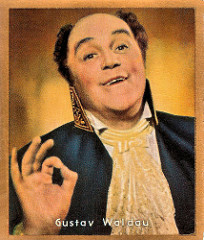
Gustav Waldau. German cigarette card in the series Unsere Bunten Filmbilder by Ross Verlag for Cigarettenfabrik Josetti, Berlin, no. 132. Photo: Cine-Allianz.
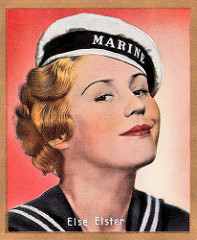
Else Elster. German cigarette card in the series Unsere Bunten Filmbilder by Ross Verlag for Cigarettenfabrik Josetti, Berlin, no. 153. Photo: Alex Binder.
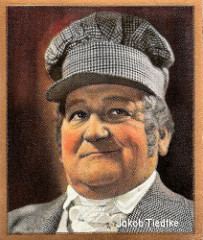
Jakob Tiedtke. German cigarette card in the series Unsere Bunten Filmbilder by Ross Verlag for Cigarettenfabrik Josetti, Berlin, no. 179. Photo: Ufa.
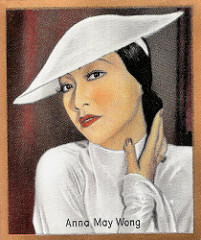
Anna May Wong . German cigarette card in the series Unsere Bunten Filmbilder by Ross Verlag for Cigarettenfabrik Josetti, Berlin, no. 187. Photo: Paramount.
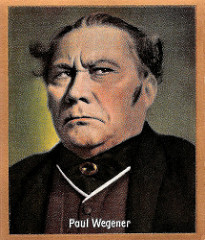
Paul Wegener . German cigarette card in the series Unsere Bunten Filmbilder by Ross Verlag for Cigarettenfabrik Josetti, Berlin, no. 193. Photo: Lilenberger.
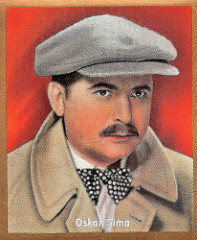
Oskar Sima. German cigarette card in the series Unsere Bunten Filmbilder by Ross Verlag for Cigarettenfabrik Josetti, Berlin, no. 198. Photo: Ufa.
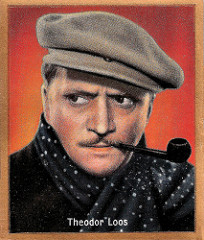
Theodor Loos. German cigarette card in the series Unsere Bunten Filmbilder by Ross Verlag for Cigarettenfabrik Josetti, Berlin, no. 200. Photo: Nostra-Film.
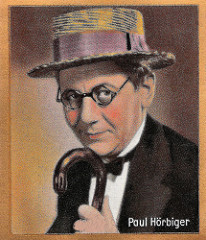
Paul Hörbiger . German cigarette card in the series Unsere Bunten Filmbilder by Ross Verlag for Cigarettenfabrik Josetti, Berlin, no. 240. Photo: Patria-Film.
This is a post for Postcard Friendship Friday, hosted by Beth at the The Best Hearts are Crunchy. You can visit her by clicking on the button below.


Greta Garbo . German cigarette card in the series Unsere Bunten Filmbilder by Ross Verlag for Cigarettenfabrik Josetti, Berlin, no. 23. Photo: Metro-Goldwyn-Mayer. Publicity still for Queen Christina (Rouben Mamoulian, 1933).

Marlene Dietrich . German cigarette card in the series Unsere Bunten Filmbilder by Ross Verlag for Cigarettenfabrik Josetti, Berlin, no. 25. Photo: Paramount. Publicity still for The Devil is a Woman (Josef von Sternberg, 1935).

Paul Kemp . German cigarette card in the series Unsere Bunten Filmbilder by Ross Verlag for Cigarettenfabrik Josetti, Berlin, no. 99. Photo: Minerva-Tonfilm.

Luis Trenker . German cigarette card in the series Unsere Bunten Filmbilder by Ross Verlag for Cigarettenfabrik Josetti, Berlin, no. 107. Photo: Rota-Film.

Gustav Waldau. German cigarette card in the series Unsere Bunten Filmbilder by Ross Verlag for Cigarettenfabrik Josetti, Berlin, no. 132. Photo: Cine-Allianz.

Else Elster. German cigarette card in the series Unsere Bunten Filmbilder by Ross Verlag for Cigarettenfabrik Josetti, Berlin, no. 153. Photo: Alex Binder.

Jakob Tiedtke. German cigarette card in the series Unsere Bunten Filmbilder by Ross Verlag for Cigarettenfabrik Josetti, Berlin, no. 179. Photo: Ufa.

Anna May Wong . German cigarette card in the series Unsere Bunten Filmbilder by Ross Verlag for Cigarettenfabrik Josetti, Berlin, no. 187. Photo: Paramount.

Paul Wegener . German cigarette card in the series Unsere Bunten Filmbilder by Ross Verlag for Cigarettenfabrik Josetti, Berlin, no. 193. Photo: Lilenberger.

Oskar Sima. German cigarette card in the series Unsere Bunten Filmbilder by Ross Verlag for Cigarettenfabrik Josetti, Berlin, no. 198. Photo: Ufa.

Theodor Loos. German cigarette card in the series Unsere Bunten Filmbilder by Ross Verlag for Cigarettenfabrik Josetti, Berlin, no. 200. Photo: Nostra-Film.

Paul Hörbiger . German cigarette card in the series Unsere Bunten Filmbilder by Ross Verlag for Cigarettenfabrik Josetti, Berlin, no. 240. Photo: Patria-Film.
This is a post for Postcard Friendship Friday, hosted by Beth at the The Best Hearts are Crunchy. You can visit her by clicking on the button below.

Published on March 31, 2016 22:00
March 30, 2016
Thierry Lhermitte
Tall and handsome Thierry Lhermitte (1952) is one of France's most popular actors, writers, and producers, best known for his roles in comedies. In the 1970s, he was one of the founders of the comedy troupe Le Splendid. The group scored major successes with films such as Les Bronzés (1978). Later L’Hermitte had a phenomenal success in France with his comedies Les Ripoux (1984) and Le Dîner de Cons (1998).
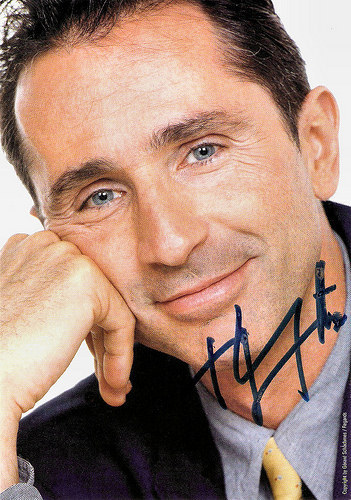
French autograph card.
Splendid
Thierry Michel Lhermitte was born in Boulogne-Billancourt, France, in 1952. He was a founder of the comedy troupe Le Splendid in the 1970s, along with Christian Clavier, Gérard Jugnot, Michel Blanc, Josiane Balasko and others.
In 1973, he made his film debut in the cult comedy L'An 01/The Year 01 (Jacques Doillon, Alain Resnais, Jean Rouch, 1973), based on the eponymous comic strip by Gébé.
He had a small part as a doorman in the hit Les Valseuses/Going Places (Bertrand Blier, 1974), starring Miou-Miou, Gérard Depardieu and Patrick Dewaere . Another small part followed in the historical drama Que la fête commence.../Let Joy Reign Supreme (Bertrand Tavernier, 1975) starring Philippe Noiret .
While he had major successes with Le Splendid in their café-théâtre, he continued to play small parts in interesting films like the dramas F comme Fairbanks (Maurice Dugowson, 1976|) starring Patrick Dewaere , and Des enfants gates/Spoiled Children (Bertrand Tavernier, 1977) with Michel Piccoli .
L’Hermitte had his breakthrough in the cinema with the comedy Les Bronzés/French Fried Vacation (Patrice Leconte, 1978). The film satirises life at holiday resorts such as Club Med. The troupe of Le Splendid, Josiane Balasko, Michel Blanc, Marie-Anne Chazel, Gérard Jugnot, Christian Clavier and L’Hermitte had written and created together the play Amours, Coquillages et Crustacés on which the scenario for Les Bronzés was based,
Les Bronzés proved to be phenomenally popular in France, where it sold 2.2 million tickets during its initial theatrical release. It inspired a dedicated cult following and two sequels, also directed by Patrice Leconte: Les Bronzés font du ski/French Fried Vacation 2 (1979) and Les Bronzés 3: Amis pour la vie/Friends Forever (2006).
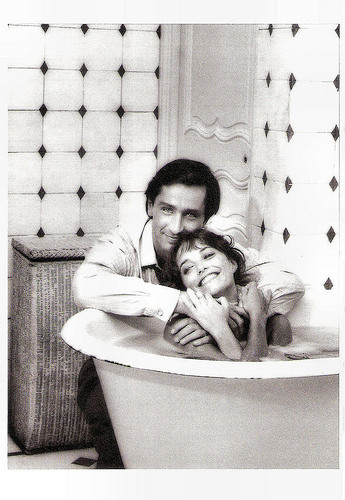
French postcard by Editions Marion Valentine, Paris, no. 232. Photo: Gilles Larrain. Publicity still for Until September (Richard Marquand, 1984) with Karen Allen.
New Partner
In the early 1980s, Thierry L’Hermitte started to play bigger parts in other film genres. He appeared in the drama La Banquière/The Lady Banker (Francis Girod,1980), starring Romy Schneider , and in the comedy drama Clara et les Chics Types (Jacques Monnet 1981) featuring Isabelle Adjani .
He starred in another filmed Splendid success, Le Père Noël est une ordure/Santa Claus Is a Stinker (Jean-Marie Poiré, 1982). He played Pierre, a stuffy, self-righteous volunteer at a telephone helpline for depressed people who is stuck with his well-meaning but naive co-worker Thérèse (Anémone), with the Christmas Eve shift in the Paris office, much to their displeasure.
He also starred with Isabelle Huppert and Coluche in the comedy La Femme de mon pote/My Best Friend's Girl (Bertrand Blier, 1983).
L’Hermitte scored a big hit in France with the comedy Les Ripoux/My New Partner (Claude Zidi, 1984), as the new, idealistic partner of a streetwise Paris policeman (Philippe Noiret). Noiret sets out to corrupt his new partner and, after a slow start, succeeds spectacularly. Les Ripoux won the César Award for Best Film in 1985.Two sequels were later made: Ripoux contre Ripoux/My New Partner II (Claude Zidi, 1990) and Ripoux 3/Part-Time Cops (Claude Zidi, 2003).
L’Hermitte also appeared in the American romantic drama Until September (Richard Marquand, 1984), in which he played a French banker who falls in love with an American tourist (Karen Allen) in Paris. In Les Rois du gag (Claude Zidi, 1985), he and Gérard Jugnot played two gagmen without fame who are hired by a famous television comic (Michel Serrault). And in Les 1001 Nuits/One Thousand and One Nights (Philippe de Broca, 1990) he co-starred as the evil king opposite Catherine Zeta-Jones as Sheherazade.
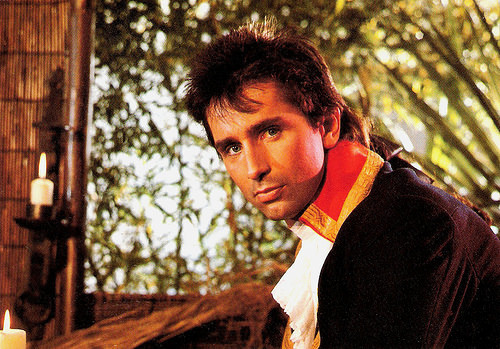
French postcard by Editions Photomania, Paris, no. G. 84. Photo: Jacques Prayer / Gamma. Publicity still for Les Rois du gag/The Gag Kings (Claude Zidi, 1985).
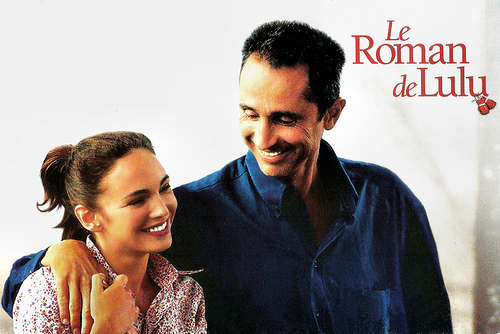
French promotion card. Photo: publicity still for Le Roman de Lulu (Pierre-Olivier Scotto, 2001) with Claire Keim.
Dinner of Idiots
Thierry L’Hermitte followed in the footsteps of Terence Hill as the partner of Bud Spencer in Un piede in paradise/Speaking of the Devil (Enzo Barboni, 1991). That year, he also starred in the French comedy La Totale! (Claude Zidi, 1991), which would be the basis for the action comedy True Lies (James Cameron, 1994) with Arnold Schwarzenegger.
Other successful comedies were Grosse Fatigue/Dead Tired (Michel Blanc, 1994) and Un indien dans la ville/Little Indian, Big City (Hervé Palud, 1994), which was remade in Hollywood as Jungle 2 Jungle (John Pasquin, 1997) with Tim Allen. He appeared as King Louis XIV in Marquise (Véra Belmont, 1997) with Sophie Marceau, and as a doctor in the poorly received An American Werewolf in Paris (Anthony Waller, 1997) starring Tom Everett Scott and Julie Delpy.
A bigger success was Le Dîner de Cons/The Dinner Game (Francis Veber, 1998). This witty comedy of manners featured L’Hermitte as an arrogant publisher who is put in his place by the seemingly moronic man (Jacques Villeret) which he has invited to his weekly dinner of idiots. The film was honoured at the 1999 César Awards with six nominations of which it won three and was a phenomenal hit with audiences.
In the new century, he steadily appeared in films and continued to work as a screenwriter and producer. His later films include Le Divorce (James Ivory, 2003), L'Ex-femme de ma vie/The Ex-Wife of My Life (Josiane Balasko, 2005) and Quai d'Orsay/The French Minister (Bertrand Tavernier, 2013). Recently, he also starred in the popular TV series Les Témoins/Witnesses (2014) by Marc Herpoux and Hervé Hadmar.
Thierry Lhermitte received several honours and awards, including the Prix Jean Gabin (1981), Chevalier of the Légion d'honneur (2001) and Officier of the Ordre national du Mérite (2005). He and his wife Hélène Lhermitte have three children, Victor Lhermitte, Louise Lhermitte and Astree Lhermitte-Soka.
Trailer Les Ripoux/My New Partner (Claude Zidi, 1984). Source: Video Detective (YouTube).
Trailer Les Bronzés 3: Amis pour la vie/Friends Forever (2006). Source: Yohann Comte (YouTube).
Trailer Quai d'Orsay/The French Minister (Bertrand Tavernier, 2013). Source: Movieclips Film Festivals & Indie Film (YouTube).
Sources: Rebecca Flint Marx (AllMovie), Wikipedia and .

French autograph card.
Splendid
Thierry Michel Lhermitte was born in Boulogne-Billancourt, France, in 1952. He was a founder of the comedy troupe Le Splendid in the 1970s, along with Christian Clavier, Gérard Jugnot, Michel Blanc, Josiane Balasko and others.
In 1973, he made his film debut in the cult comedy L'An 01/The Year 01 (Jacques Doillon, Alain Resnais, Jean Rouch, 1973), based on the eponymous comic strip by Gébé.
He had a small part as a doorman in the hit Les Valseuses/Going Places (Bertrand Blier, 1974), starring Miou-Miou, Gérard Depardieu and Patrick Dewaere . Another small part followed in the historical drama Que la fête commence.../Let Joy Reign Supreme (Bertrand Tavernier, 1975) starring Philippe Noiret .
While he had major successes with Le Splendid in their café-théâtre, he continued to play small parts in interesting films like the dramas F comme Fairbanks (Maurice Dugowson, 1976|) starring Patrick Dewaere , and Des enfants gates/Spoiled Children (Bertrand Tavernier, 1977) with Michel Piccoli .
L’Hermitte had his breakthrough in the cinema with the comedy Les Bronzés/French Fried Vacation (Patrice Leconte, 1978). The film satirises life at holiday resorts such as Club Med. The troupe of Le Splendid, Josiane Balasko, Michel Blanc, Marie-Anne Chazel, Gérard Jugnot, Christian Clavier and L’Hermitte had written and created together the play Amours, Coquillages et Crustacés on which the scenario for Les Bronzés was based,
Les Bronzés proved to be phenomenally popular in France, where it sold 2.2 million tickets during its initial theatrical release. It inspired a dedicated cult following and two sequels, also directed by Patrice Leconte: Les Bronzés font du ski/French Fried Vacation 2 (1979) and Les Bronzés 3: Amis pour la vie/Friends Forever (2006).

French postcard by Editions Marion Valentine, Paris, no. 232. Photo: Gilles Larrain. Publicity still for Until September (Richard Marquand, 1984) with Karen Allen.
New Partner
In the early 1980s, Thierry L’Hermitte started to play bigger parts in other film genres. He appeared in the drama La Banquière/The Lady Banker (Francis Girod,1980), starring Romy Schneider , and in the comedy drama Clara et les Chics Types (Jacques Monnet 1981) featuring Isabelle Adjani .
He starred in another filmed Splendid success, Le Père Noël est une ordure/Santa Claus Is a Stinker (Jean-Marie Poiré, 1982). He played Pierre, a stuffy, self-righteous volunteer at a telephone helpline for depressed people who is stuck with his well-meaning but naive co-worker Thérèse (Anémone), with the Christmas Eve shift in the Paris office, much to their displeasure.
He also starred with Isabelle Huppert and Coluche in the comedy La Femme de mon pote/My Best Friend's Girl (Bertrand Blier, 1983).
L’Hermitte scored a big hit in France with the comedy Les Ripoux/My New Partner (Claude Zidi, 1984), as the new, idealistic partner of a streetwise Paris policeman (Philippe Noiret). Noiret sets out to corrupt his new partner and, after a slow start, succeeds spectacularly. Les Ripoux won the César Award for Best Film in 1985.Two sequels were later made: Ripoux contre Ripoux/My New Partner II (Claude Zidi, 1990) and Ripoux 3/Part-Time Cops (Claude Zidi, 2003).
L’Hermitte also appeared in the American romantic drama Until September (Richard Marquand, 1984), in which he played a French banker who falls in love with an American tourist (Karen Allen) in Paris. In Les Rois du gag (Claude Zidi, 1985), he and Gérard Jugnot played two gagmen without fame who are hired by a famous television comic (Michel Serrault). And in Les 1001 Nuits/One Thousand and One Nights (Philippe de Broca, 1990) he co-starred as the evil king opposite Catherine Zeta-Jones as Sheherazade.

French postcard by Editions Photomania, Paris, no. G. 84. Photo: Jacques Prayer / Gamma. Publicity still for Les Rois du gag/The Gag Kings (Claude Zidi, 1985).

French promotion card. Photo: publicity still for Le Roman de Lulu (Pierre-Olivier Scotto, 2001) with Claire Keim.
Dinner of Idiots
Thierry L’Hermitte followed in the footsteps of Terence Hill as the partner of Bud Spencer in Un piede in paradise/Speaking of the Devil (Enzo Barboni, 1991). That year, he also starred in the French comedy La Totale! (Claude Zidi, 1991), which would be the basis for the action comedy True Lies (James Cameron, 1994) with Arnold Schwarzenegger.
Other successful comedies were Grosse Fatigue/Dead Tired (Michel Blanc, 1994) and Un indien dans la ville/Little Indian, Big City (Hervé Palud, 1994), which was remade in Hollywood as Jungle 2 Jungle (John Pasquin, 1997) with Tim Allen. He appeared as King Louis XIV in Marquise (Véra Belmont, 1997) with Sophie Marceau, and as a doctor in the poorly received An American Werewolf in Paris (Anthony Waller, 1997) starring Tom Everett Scott and Julie Delpy.
A bigger success was Le Dîner de Cons/The Dinner Game (Francis Veber, 1998). This witty comedy of manners featured L’Hermitte as an arrogant publisher who is put in his place by the seemingly moronic man (Jacques Villeret) which he has invited to his weekly dinner of idiots. The film was honoured at the 1999 César Awards with six nominations of which it won three and was a phenomenal hit with audiences.
In the new century, he steadily appeared in films and continued to work as a screenwriter and producer. His later films include Le Divorce (James Ivory, 2003), L'Ex-femme de ma vie/The Ex-Wife of My Life (Josiane Balasko, 2005) and Quai d'Orsay/The French Minister (Bertrand Tavernier, 2013). Recently, he also starred in the popular TV series Les Témoins/Witnesses (2014) by Marc Herpoux and Hervé Hadmar.
Thierry Lhermitte received several honours and awards, including the Prix Jean Gabin (1981), Chevalier of the Légion d'honneur (2001) and Officier of the Ordre national du Mérite (2005). He and his wife Hélène Lhermitte have three children, Victor Lhermitte, Louise Lhermitte and Astree Lhermitte-Soka.
Trailer Les Ripoux/My New Partner (Claude Zidi, 1984). Source: Video Detective (YouTube).
Trailer Les Bronzés 3: Amis pour la vie/Friends Forever (2006). Source: Yohann Comte (YouTube).
Trailer Quai d'Orsay/The French Minister (Bertrand Tavernier, 2013). Source: Movieclips Film Festivals & Indie Film (YouTube).
Sources: Rebecca Flint Marx (AllMovie), Wikipedia and .
Published on March 30, 2016 22:00
March 29, 2016
Imported from the USA: Marlon Brando
American film star Marlon Brando (1924-2004) was one of the greatest and most influential actors of all time. A cultural icon, Brando is most famous for his Oscar-winning performances as Terry Malloy in On the Waterfront (Elia Kazan, 1954) and Don Vito Corleone in The Godfather (1972). During the 1960s and 1970, he starred in several European films, including Bernardo Bertolucci's Ultimo tango a Parigi/Last Tango in Paris (1972).
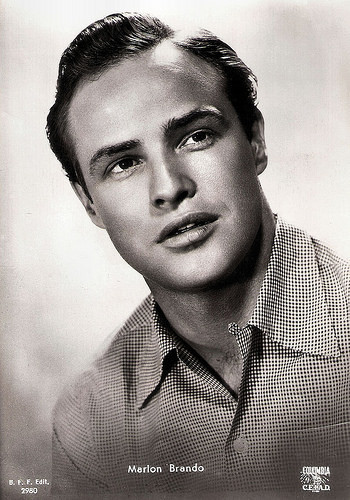
Italian postcard by B.F.F. Edit., no. 2980. Photo: Columbia / C.E.I.A.D.
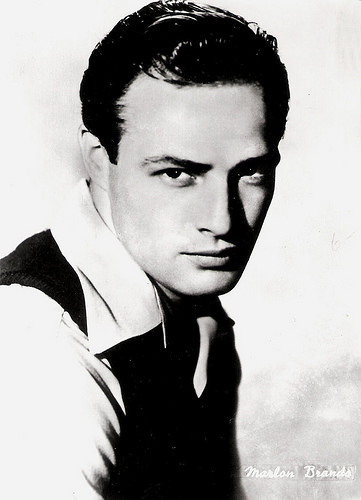
Italian postcard by Bromofoto, Milano.
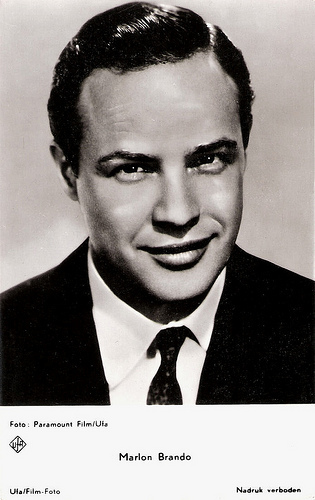
Dutch postcard by Gebr. Spanjersberg N.V., Rotterdam, no. 4992. Photo: Paramount Film / Ufa.
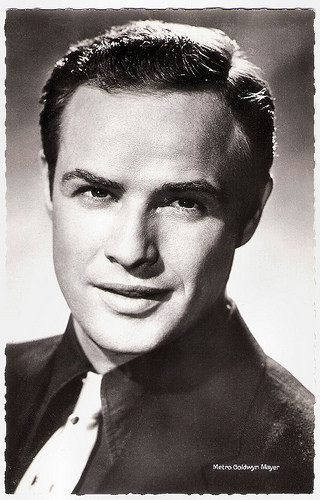
French postcard by Editions du Globe, no. 535. Photo: Metro-Goldwyn-Mayer. Publicity still for Guys and Dolls (Joseph L. Mankiewicz, 1955).
Stella! Stella!
Marlon Brando was born in 1924, in Omaha, Nebraska, to Marlon Brando, Sr., a pesticide and chemical feed manufacturer, and and his artistically inclined wife, the former Dorothy Julia Pennebaker. Brando had two older sisters, Jocelyn Brando (1919–2005) and Frances (1922–1994). Jocelyn was the first to pursue an acting career, going to study at the American Academy of Dramatic Art in New York City. She appeared on Broadway, then films and television. Marlon had been held back a year in school and was later expelled from Libertyville High School for riding his motorcycle through the corridors.
In 1943, he decided to follow his sister to New York. Brando enrolled in Erwin Piscator's Dramatic Workshop at New York's New School, and was mentored by Stella Adler, a member of a famous Yiddish Theatre acting family. Adler helped introduce to the New York stage the 'emotional memory' technique of Russian theatrical actor, director and impresario Konstantin Stanislavski, whose motto was "Think of your own experiences and use them truthfully." This technique encouraged the actor to explore his own feelings and past experiences to fully realise the character being portrayed. Brando's remarkable insight and sense of realism was evident early on.
In 1944, he made it to Broadway in the bittersweet drama I Remember Mama, playing the son of Mady Christians . New York Drama Critics voted him 'Most Promising Young Actor' for his role as an anguished veteran in Truckline Café, although the play was a commercial failure. His breakthrough was the role of Stanley Kowalski in Tennessee Williams's 1947 play A Streetcar Named Desire, directed by Elia Kazan. Brando based his portrayal of Kowalski on the boxer Rocky Graziano, whom he had studied at a local gymnasium.
Brando's first screen role was the bitter paraplegic war veteran in The Men (Fred Zinnemann, 1950). In typical Method fashion, he spent a month in an actual veteran's hospital in preparation for the role. Brando rose to fame when he repeated the role of Stanley Kowalski in the film A Streetcar Named Desire (Elia Kazan, 1951). The role is regarded as one of Brando's greatest. The reception of Brando's performance was so positive that Brando quickly became a male sex symbol in Hollywood. The role earned him his first Academy Award nomination, but lost despite Oscars for his co-stars, Vivien Leigh , Karl Malden, and Kim Hunter.
Brando was also Oscar nominated the next year for Viva Zapata! (Elia Kazan, 1952), a fictionalised account of the life of Mexican revolutionary Emiliano Zapata. His next film, Julius Caesar (Joseph L. Mankiewicz, 1953), received highly favourable reviews. Brando portrayed Mark Antony opposite John Gielgud . Another iconic portrayal is the rebel motorcycle gang leader Johnny Strabler in The Wild One (Laslo Benedek, 1953), riding his own Triumph Thunderbird 6T motorcycle. His rowdy portrayal is considered to be one of the most famous images in pop culture. After the movie's release, the sales of leather jackets and blue jeans skyrocketed.
Then followed his Academy Award-winning performance as Terry Malloy in On the Waterfront (Elia Kazan, 1954), a crime drama about union violence and corruption among longshoremen. As the decade continued, Brando remained a top box office draw but critics felt his performances were half-hearted, lacking the intensity and commitment found in his earlier work. He co-starred with Jean Simmons in Désirée (Heny Koster, 1954) and the musical Guys and Dolls (Joseph L. Mankiewicz, 1955).
In Sayonara (Joshua Logan, 1957) he appeared as a United States Air Force Major Lloyd Gruver. The film was controversial due to openly discussing interracial marriage but proved a great success, earning 10 Academy Award nominations, with Brando being nominated for Best Actor. The following year, Brando appeared opposite Montgomery Clift as the sympathetic Nazi officer Christian Diestl in The Young Lions (Edward Dmytryk, 1958), dyeing his hair blonde and assuming a German accent for the role, which he later admitted was not convincing. The film was the last hit Brando would have for more than a decade.
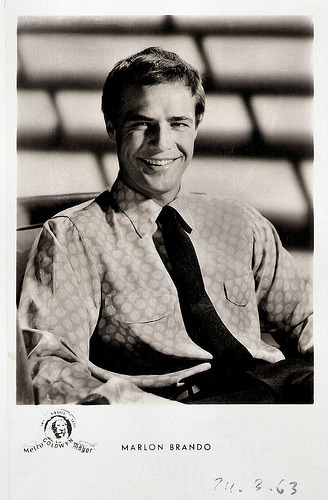
German postcard by Kunst und Bild, no. L 969. Photo: Metro-Goldwyn-Mayer. Publicity still for Julius Caesar (Joseph L. Mankiewicz, 1953).
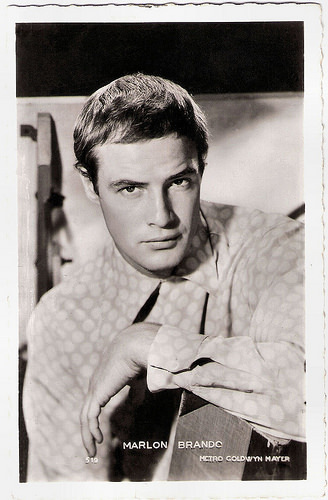
French postcard by Editions P.I., Paris, no. 2.55 H. Photo: Metro-Goldwyn-Mayer, 1954.
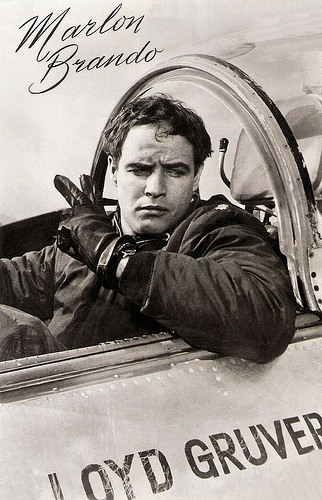
Dutch postcard by Uitgeverij Takken, Utrecht, no. 3730. Photo: Warner Bros. Publicity still for Sayonara (Joshua Logan, 1957).
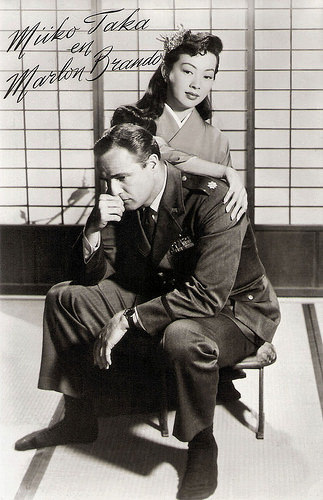
Dutch postcard by Uitgeverij Takken, Utrecht, no. 3734. Photo: Warner Bros. Publicity still for Sayonara (Joshua Logan, 1957) with Miiko Taka.
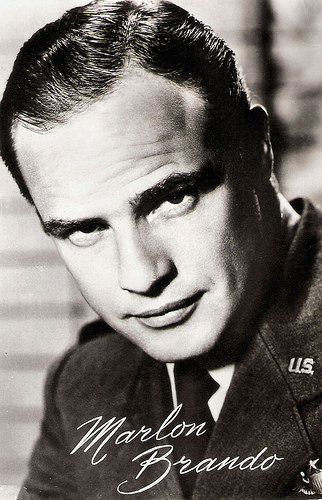
Dutch postcard by Uitgeverij Takken, Utrecht, no. 3709. Photo: Warner Bros. Publicity still for Sayonara (Joshua Logan, 1957).
The horror! The horror!
Marlo Brando directed and starred in the cult Western One-Eyed Jacks (1961), a critical and commercial flop. After both Stanley Kubrick and Sam Peckinpah had walked off the project, Brando had grabbed the directorial reins. He never again directed another film. During the 1960s, he delivered a series of box-office failures, beginning with the film adaptation of the novel Mutiny on the Bounty (Lewis Milestone, 1962). Brando's revulsion with the film industry reportedly boiled over on the set of this film. His diminishing box-office stature, combined with his increasingly temperamental behaviour, made him a target of scorn for the first time in his career.
The downward spiral continued for some years. Interesting was Reflections in a Golden Eye (John Huston, 1967), an adaptation of a Carson McCullers novel in which he portrayed a closeted and repressed gay army officer. He also did influential performances in The Chase (Arthur Penn, 1966), the Italian-French anti-colonialist drama Queimada/Burn! (Gillo Pontecorvo, 1970) and the British horror film The Nightcomers (Michael Winner, 1971). However the films were financial flops and Hollywood began to perceive him as a bad and unnecessary risk.
By the dawn of the 1970s, Brando was considered 'unbankable' and critics were becoming increasingly dismissive of his work. Brando's performance as Don Vito Corleone in The Godfather (1972), Francis Ford Coppola's adaptation of Mario Puzo's 1969 bestseller, was a career turning point. The Godfather was then one of the most commercially successful films of all time. The film put him back in the Top Ten and won him his second Best Actor Oscar. He followed The Godfather with Ultimo tango a Parigi/Last Tango in Paris (Bernardo Bertolucci, 1972) opposite Maria Schneider. The film features several intense, graphic scenes involving Brando, and the controversial film was another hit.
Brando took a four-year hiatus before appearing in the Western The Missouri Breaks (Arthur Penn, 1976) with Jack Nicholson. Then he made a rare appearance on television in the miniseries Roots: The Next Generations (1979), for which he won an Emmy award. In this period, he was content with being a highly paid character actor in glorified cameo roles, such as in Superman (Richard Donner, 1978) and The Formula (John G. Avildsen, 1980), before taking a nine-year break from motion pictures. However, he also did his controversial performance as Colonel Kurtz in the Vietnam epic Apocalypse Now (Francis Coppola, 1979). The film earned critical acclaim, as did Brando's performance. Marlon's whispering of Kurtz's final words "The horror! The horror!", has become particularly famous. It was his last great performance.
Years later though, he did receive an eighth and final Oscar nomination for his supporting role as an attorney in the anti-Apartheid drama A Dry White Season (Euzhan Palcy, 1989) after coming out of a near-decade-long retirement. Brando was an activist with deep political convictions, supporting many causes, notably the African-American Civil Rights Movement and various American Indian Movements. He made another comeback in the Johnny Depp romantic drama Don Juan DeMarco (Jeremy Leven, 1994), which co-starred Faye Dunaway as his wife.
Brando owned a private island off the Pacific coast, the Polynesian atoll known as Tetiaroa, from 1966 until his death in 2004. He was married three times. First to actress Anna Kashfi in 1957. They divorced in 1959. In 1960, Brando married Movita Castaneda, a Mexican-American actress seven years his senior; they were divorced in 1962. Tahitian actress Tarita Teriipaia, who played Brando's love interest in Mutiny on the Bounty, became his third wife in 1962. She was 20 years old, 18 years younger than Brando. They divorced in 1972. Brando had a long-term relationship with his housekeeper Maria Christina Ruiz, by whom he had three children. In 2004, Marlon Brando died of respiratory failure in Westwood, California, at age 80. He left behind 14 children (two of his children, Cheyenne and Dylan Brando, had predeceased him), as well as over 30 grandchildren.
The last words are for Jason Ankeny at AllMovie : "Marlon Brando was quite simply one of the most celebrated and influential screen and stage actors of the postwar era; he rewrote the rules of performing, and nothing was ever the same again. Brooding, lusty, and intense, his greatest contribution was popularizing Method acting, a highly interpretive performance style which brought unforeseen dimensions of power and depth to the craft. (...) He is one of the screen's greatest enigmas, and there will never be another quite like him."
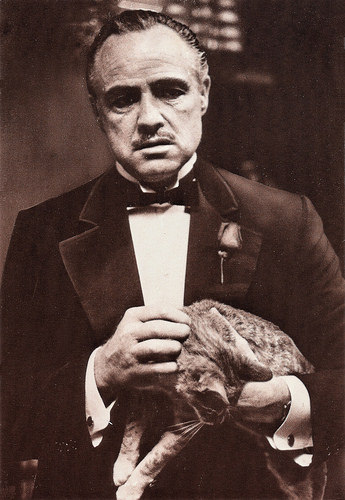
American postcard by Classico San Francisco, no. 136-183. Photo: The Ludlow Collection. Publicity still for The Godfather (Francis Ford Coppola, 1972).
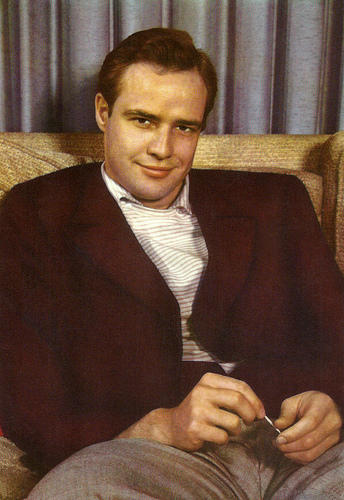
Italian postcard by Rotalcolor / Rotalfoto.
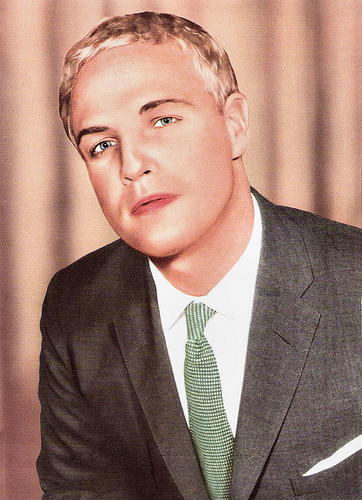
German postcard by Ufa. Photo: Dieter E. Schmidt. Incredibly coloured and polished version of the American star. The chromatic blond seems to be from the time Brando played a Nazi officer in The Young Lions (Edward Dmytryk, 1958).
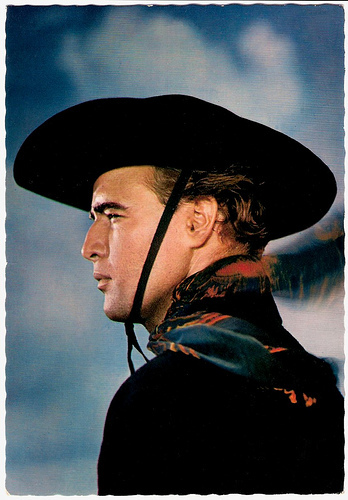
French postcard by EDUG, no. 133. Sent by mail in 1961. Photo: publicity still for One-Eyed Jacks (Marlon Brando, 1961).
Trailer for The Night of the Following Day (Hubert Cornfield, 1968). Source: (YouTube). Co-star Richard Boone directed the final scenes of the film at the insistence of Brando, who could no longer tolerate what he considered the incompetence of director Hubert Cornfield. The British film is by some considered the nadir of Brando's career.
Trailer for Last Tango in Paris (Bernardo Bertolucci, 1972). Source: Download HD (YouTube).
Sources: Jason Ankeny (AllMovie), (IMDb), Wikipedia and .

Italian postcard by B.F.F. Edit., no. 2980. Photo: Columbia / C.E.I.A.D.

Italian postcard by Bromofoto, Milano.

Dutch postcard by Gebr. Spanjersberg N.V., Rotterdam, no. 4992. Photo: Paramount Film / Ufa.

French postcard by Editions du Globe, no. 535. Photo: Metro-Goldwyn-Mayer. Publicity still for Guys and Dolls (Joseph L. Mankiewicz, 1955).
Stella! Stella!
Marlon Brando was born in 1924, in Omaha, Nebraska, to Marlon Brando, Sr., a pesticide and chemical feed manufacturer, and and his artistically inclined wife, the former Dorothy Julia Pennebaker. Brando had two older sisters, Jocelyn Brando (1919–2005) and Frances (1922–1994). Jocelyn was the first to pursue an acting career, going to study at the American Academy of Dramatic Art in New York City. She appeared on Broadway, then films and television. Marlon had been held back a year in school and was later expelled from Libertyville High School for riding his motorcycle through the corridors.
In 1943, he decided to follow his sister to New York. Brando enrolled in Erwin Piscator's Dramatic Workshop at New York's New School, and was mentored by Stella Adler, a member of a famous Yiddish Theatre acting family. Adler helped introduce to the New York stage the 'emotional memory' technique of Russian theatrical actor, director and impresario Konstantin Stanislavski, whose motto was "Think of your own experiences and use them truthfully." This technique encouraged the actor to explore his own feelings and past experiences to fully realise the character being portrayed. Brando's remarkable insight and sense of realism was evident early on.
In 1944, he made it to Broadway in the bittersweet drama I Remember Mama, playing the son of Mady Christians . New York Drama Critics voted him 'Most Promising Young Actor' for his role as an anguished veteran in Truckline Café, although the play was a commercial failure. His breakthrough was the role of Stanley Kowalski in Tennessee Williams's 1947 play A Streetcar Named Desire, directed by Elia Kazan. Brando based his portrayal of Kowalski on the boxer Rocky Graziano, whom he had studied at a local gymnasium.
Brando's first screen role was the bitter paraplegic war veteran in The Men (Fred Zinnemann, 1950). In typical Method fashion, he spent a month in an actual veteran's hospital in preparation for the role. Brando rose to fame when he repeated the role of Stanley Kowalski in the film A Streetcar Named Desire (Elia Kazan, 1951). The role is regarded as one of Brando's greatest. The reception of Brando's performance was so positive that Brando quickly became a male sex symbol in Hollywood. The role earned him his first Academy Award nomination, but lost despite Oscars for his co-stars, Vivien Leigh , Karl Malden, and Kim Hunter.
Brando was also Oscar nominated the next year for Viva Zapata! (Elia Kazan, 1952), a fictionalised account of the life of Mexican revolutionary Emiliano Zapata. His next film, Julius Caesar (Joseph L. Mankiewicz, 1953), received highly favourable reviews. Brando portrayed Mark Antony opposite John Gielgud . Another iconic portrayal is the rebel motorcycle gang leader Johnny Strabler in The Wild One (Laslo Benedek, 1953), riding his own Triumph Thunderbird 6T motorcycle. His rowdy portrayal is considered to be one of the most famous images in pop culture. After the movie's release, the sales of leather jackets and blue jeans skyrocketed.
Then followed his Academy Award-winning performance as Terry Malloy in On the Waterfront (Elia Kazan, 1954), a crime drama about union violence and corruption among longshoremen. As the decade continued, Brando remained a top box office draw but critics felt his performances were half-hearted, lacking the intensity and commitment found in his earlier work. He co-starred with Jean Simmons in Désirée (Heny Koster, 1954) and the musical Guys and Dolls (Joseph L. Mankiewicz, 1955).
In Sayonara (Joshua Logan, 1957) he appeared as a United States Air Force Major Lloyd Gruver. The film was controversial due to openly discussing interracial marriage but proved a great success, earning 10 Academy Award nominations, with Brando being nominated for Best Actor. The following year, Brando appeared opposite Montgomery Clift as the sympathetic Nazi officer Christian Diestl in The Young Lions (Edward Dmytryk, 1958), dyeing his hair blonde and assuming a German accent for the role, which he later admitted was not convincing. The film was the last hit Brando would have for more than a decade.

German postcard by Kunst und Bild, no. L 969. Photo: Metro-Goldwyn-Mayer. Publicity still for Julius Caesar (Joseph L. Mankiewicz, 1953).

French postcard by Editions P.I., Paris, no. 2.55 H. Photo: Metro-Goldwyn-Mayer, 1954.

Dutch postcard by Uitgeverij Takken, Utrecht, no. 3730. Photo: Warner Bros. Publicity still for Sayonara (Joshua Logan, 1957).

Dutch postcard by Uitgeverij Takken, Utrecht, no. 3734. Photo: Warner Bros. Publicity still for Sayonara (Joshua Logan, 1957) with Miiko Taka.

Dutch postcard by Uitgeverij Takken, Utrecht, no. 3709. Photo: Warner Bros. Publicity still for Sayonara (Joshua Logan, 1957).
The horror! The horror!
Marlo Brando directed and starred in the cult Western One-Eyed Jacks (1961), a critical and commercial flop. After both Stanley Kubrick and Sam Peckinpah had walked off the project, Brando had grabbed the directorial reins. He never again directed another film. During the 1960s, he delivered a series of box-office failures, beginning with the film adaptation of the novel Mutiny on the Bounty (Lewis Milestone, 1962). Brando's revulsion with the film industry reportedly boiled over on the set of this film. His diminishing box-office stature, combined with his increasingly temperamental behaviour, made him a target of scorn for the first time in his career.
The downward spiral continued for some years. Interesting was Reflections in a Golden Eye (John Huston, 1967), an adaptation of a Carson McCullers novel in which he portrayed a closeted and repressed gay army officer. He also did influential performances in The Chase (Arthur Penn, 1966), the Italian-French anti-colonialist drama Queimada/Burn! (Gillo Pontecorvo, 1970) and the British horror film The Nightcomers (Michael Winner, 1971). However the films were financial flops and Hollywood began to perceive him as a bad and unnecessary risk.
By the dawn of the 1970s, Brando was considered 'unbankable' and critics were becoming increasingly dismissive of his work. Brando's performance as Don Vito Corleone in The Godfather (1972), Francis Ford Coppola's adaptation of Mario Puzo's 1969 bestseller, was a career turning point. The Godfather was then one of the most commercially successful films of all time. The film put him back in the Top Ten and won him his second Best Actor Oscar. He followed The Godfather with Ultimo tango a Parigi/Last Tango in Paris (Bernardo Bertolucci, 1972) opposite Maria Schneider. The film features several intense, graphic scenes involving Brando, and the controversial film was another hit.
Brando took a four-year hiatus before appearing in the Western The Missouri Breaks (Arthur Penn, 1976) with Jack Nicholson. Then he made a rare appearance on television in the miniseries Roots: The Next Generations (1979), for which he won an Emmy award. In this period, he was content with being a highly paid character actor in glorified cameo roles, such as in Superman (Richard Donner, 1978) and The Formula (John G. Avildsen, 1980), before taking a nine-year break from motion pictures. However, he also did his controversial performance as Colonel Kurtz in the Vietnam epic Apocalypse Now (Francis Coppola, 1979). The film earned critical acclaim, as did Brando's performance. Marlon's whispering of Kurtz's final words "The horror! The horror!", has become particularly famous. It was his last great performance.
Years later though, he did receive an eighth and final Oscar nomination for his supporting role as an attorney in the anti-Apartheid drama A Dry White Season (Euzhan Palcy, 1989) after coming out of a near-decade-long retirement. Brando was an activist with deep political convictions, supporting many causes, notably the African-American Civil Rights Movement and various American Indian Movements. He made another comeback in the Johnny Depp romantic drama Don Juan DeMarco (Jeremy Leven, 1994), which co-starred Faye Dunaway as his wife.
Brando owned a private island off the Pacific coast, the Polynesian atoll known as Tetiaroa, from 1966 until his death in 2004. He was married three times. First to actress Anna Kashfi in 1957. They divorced in 1959. In 1960, Brando married Movita Castaneda, a Mexican-American actress seven years his senior; they were divorced in 1962. Tahitian actress Tarita Teriipaia, who played Brando's love interest in Mutiny on the Bounty, became his third wife in 1962. She was 20 years old, 18 years younger than Brando. They divorced in 1972. Brando had a long-term relationship with his housekeeper Maria Christina Ruiz, by whom he had three children. In 2004, Marlon Brando died of respiratory failure in Westwood, California, at age 80. He left behind 14 children (two of his children, Cheyenne and Dylan Brando, had predeceased him), as well as over 30 grandchildren.
The last words are for Jason Ankeny at AllMovie : "Marlon Brando was quite simply one of the most celebrated and influential screen and stage actors of the postwar era; he rewrote the rules of performing, and nothing was ever the same again. Brooding, lusty, and intense, his greatest contribution was popularizing Method acting, a highly interpretive performance style which brought unforeseen dimensions of power and depth to the craft. (...) He is one of the screen's greatest enigmas, and there will never be another quite like him."

American postcard by Classico San Francisco, no. 136-183. Photo: The Ludlow Collection. Publicity still for The Godfather (Francis Ford Coppola, 1972).

Italian postcard by Rotalcolor / Rotalfoto.

German postcard by Ufa. Photo: Dieter E. Schmidt. Incredibly coloured and polished version of the American star. The chromatic blond seems to be from the time Brando played a Nazi officer in The Young Lions (Edward Dmytryk, 1958).

French postcard by EDUG, no. 133. Sent by mail in 1961. Photo: publicity still for One-Eyed Jacks (Marlon Brando, 1961).
Trailer for The Night of the Following Day (Hubert Cornfield, 1968). Source: (YouTube). Co-star Richard Boone directed the final scenes of the film at the insistence of Brando, who could no longer tolerate what he considered the incompetence of director Hubert Cornfield. The British film is by some considered the nadir of Brando's career.
Trailer for Last Tango in Paris (Bernardo Bertolucci, 1972). Source: Download HD (YouTube).
Sources: Jason Ankeny (AllMovie), (IMDb), Wikipedia and .
Published on March 29, 2016 22:00
March 28, 2016
Alfred Abel
Elegant Alfred Abel (1879-1937) is best known as the industrial Joh. Fredersen in Fritz Lang's silent masterpiece Metropolis (1926). Abel played in over 140 silent and sound films between 1913 and 1938, and also worked as a director and producer.
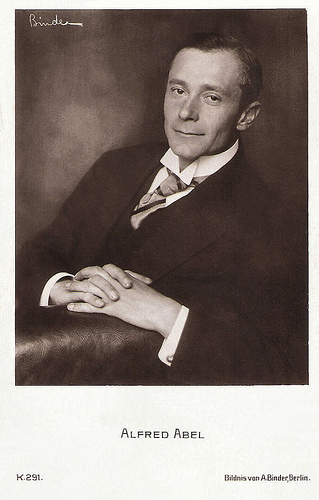
German postcard by Photochemie, Berlin, no. K. 291. Photo: Alex Binder.
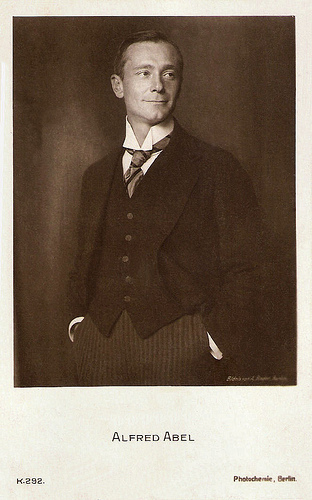
German postcard by Photochemie, Berlin, no. K. 292. Photo: Alex Binder.
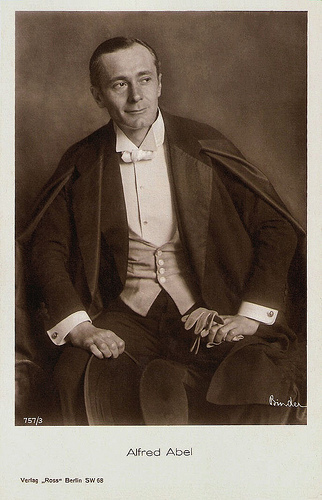
German postcard by Ross Verlag, Berlin, no. 757/3, 1919-1924. Photo: Alex Binder.
Arrogant Industrial
Alfred Peter Abel was born in Leipzig in the German empire in 1879. He was the son of a travelling salesman, Louis Abel, and his wife, Anna Maria Selma. He studied to be a forester, a gardener and a businessman before he attended private acting classes.
After making his stage debut in Luzern (Lucerne), Switzerland, he moved to the Baranowsky Theater in Berlin under the direction of Max Reinhardt. He quickly gained fame and was called to do several other acting jobs. Abel garnered international success with his guest performance at the Irving Place Theatre in New York City. In 1904 he joined Max Reinhardt's Deutsches Theater in Berlin, where he stayed for the next ten years.
At age 33, he made his film debut in Eine venezianische Nacht/One Night in Venice (Max Reinhardt, 1913) opposite Maria Carmi . That was the start of an extensive career in the German silent cinema.
He played for genius directors such as Ernst Lubitsch , Friedrich Wilhelm Murnau, and Fritz Lang, and appeared opposite the great stars of the Weimar cinema: Asta Nielsen, Henny Porten and Pola Negri .
Memorable are his performances in such films as Der brennende Acker/Burning Soil (Friedrich Wilhelm Murnau, 1922) with Lya de Putti , Phantom/The Phantom (Friedrich Wilhelm Murnau, 1922) with Lil Dagover , and Die Finanzen des Grosshertogs/The Grand Duke's Finances (Friedrich Wilhelm Murnau, 1923), Dr. Mabuse der Spieler/Dr. Mabuse, the Gambler (Fritz Lang, 1922) with Rudolf Klein-Rogge , Die Flamme/The Flame (Ernst Lubitsch, 1922) starring Pola Negri , and Marcel L'Herbier's film adaptation of Emile Zola's L'Argent/The Money (1928).
In particular his role as the arrogant industrial Joh. Fredersen in the SF-classic Metropolis (Fritz Lang, 1926) is unforgettable. As Fredersen he was the leader of the metropolis.
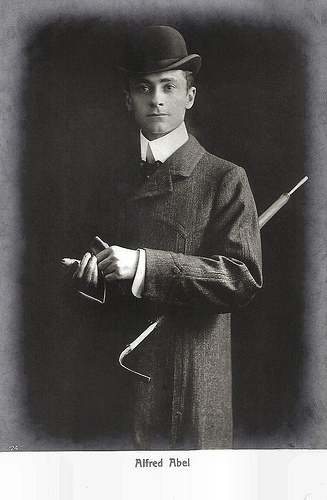
German postcard, no. 224.
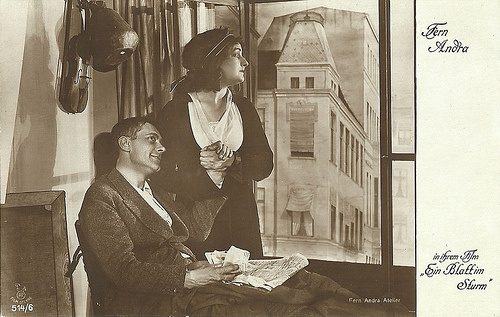
German postcard in the Film-Sterne series by Rotophot, no. 514/6. Photo: Fern Andra Atelier. Fern Andra and Alfred Abel in the German silent film Ein Blatt im Sturm ... doch das Schicksal hat es verweht (n.n., 1917).
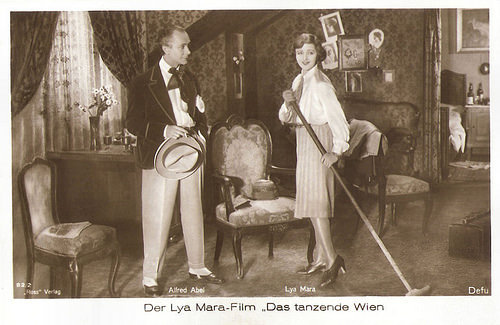
German postcard by Ross Verlag, no. 82/2. Photo: Defu. Publicity still for Das tanzende Wien/Dancing Vienna (Friedrich Zelnik, 1927) with Lya Mara .
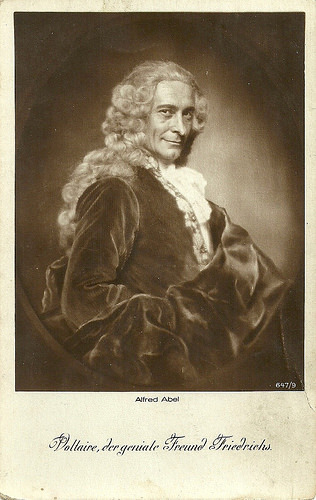
German postcard by Ross Verlag, no. 647/9. Photo: Karl Schenker. Caption: Alfred Abel as 'Voltaire, the genial friend of Frederick [the Great]'. NB Alfred Abel is not listed as playing Voltaire in any of the Frederick the Great films, but the back of this postcard states this is for the Fridericus Rex series (1922-1923) by Arzén von Cserépy for Cserepy Film Co.
Cropped-up Emotions and Tensions
Alfred Abel was known for his restrained performances, expressing cropped up emotions and tensions, quite the contrary of stage acting. Although he was a trained stage actor, he understood well that film acting was something different. When sound film came in, Abel easily switched to talking roles.
During the sound era, he played in films by Detlef Sierck (aka Douglas Sirk), Paul Martin, Reinhold Schünzel and Anatole Litvak.
Among his most popular sound films were Dolly macht Karriere/Dolly’s Way to Stardom (Anatole Litvak, 1930) with Dolly Haas , Meine, Frau, die Hochstaplerin/My Wife the Confidence Trickster (Kurt Gerron, 1931) and the classic film operetta Der Kongress tanzt/The Congress Dances (Erik Charell, 1931) starring Lilian Harvey and Willy Fritsch .
Abel also played the lead in Mary (1931), the German version of Alfred Hitchcock's Murder (1930). Hitchcock later told Francois Truffaut (in his book Hitchcock on Hitchcock) that Mary featured 'things we did for the first time': stream of consciousness, play in the play a la Hamlet, references to transvestism and even hints at (veiled) homosexuality, which was a 'crime' in Great Britain as it was in Germany at the time.
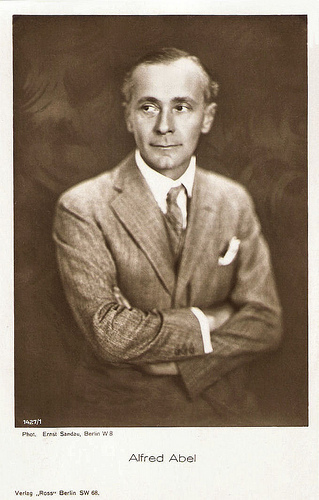
German postcard by Ross Verlag, Berlin, no. 1427/1, 1927-1928. Photo: Ernst Sandau.
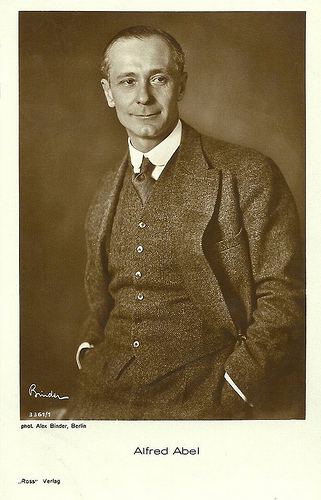
German postcard by Ross Verlag, no. 3161/1, 1928-1929. Photo: Alex Binder.
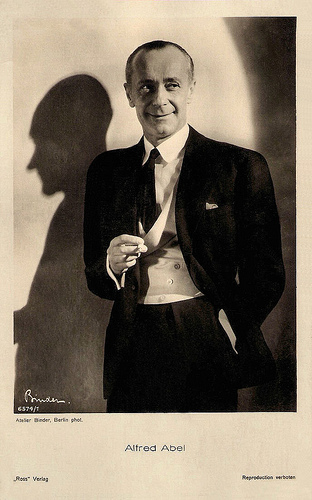
German postcard by Ross Verlag, no. 6574/1, 1931-1932. Photo: Atelier Binder, Berlin.
Aryan Heritage
Alfred Abel had the reputation in Berlin to be one of the best-dressed men and he gladly gave his opinion about fashion. He became more and restricted to the role type of elegant, intelligent gentlemen and aristocrats and he tried to counterbalance this with satirical gestures, for instance, in Hofkonzert/The Court Concert (Detlev Sierck, 1936) with Marta Eggerth .
In the early 1920's, Abel had tried film direction and created the production company Artifex Film. His directorial debut Der Streik der Diebe/The Strike of the Thieves (Alfred Abel, 1921) flopped, but in 1929 he tried it again with Narkose/Narcosis (Alfred Abel, 1929).
This was followed by Glückliche Reise/Bon Voyage (Alfred Abel, 1933) with Magda Schneider and Alles um eine Frau/Everything for a Woman (Alfred Abel, 1935) starring Gustav Diessl .
Abel was married to Elizabeth Seidel with whom he had one daughter actress Ursula Abel. In 1935, the Nazi regime prohibited Ursula in 1935 from appearing in subsequent films after she failed to produce ancestry papers (Ariernachweis) for her father to prove he was not of Jewish descent.
After battling a long illness, Alfred Abel died in 1937 in Berlin. Abel’s final film role was as Daffinger in Frau Sylvelin (Herbert Maisch, 1938), which was not released until after his death.
Great scene from Phantom (1922). Source: Blowskiol (YouTube).
Another scene from Phantom (1922). Source: Flicker Alley (YouTube).
Trailer for Metropolis (1927). Source: Ageless Trailers (YouTube).
Sources: Thomas Staedeli (Cyranos), Stephanie D'heil (Steffi-line) (German), Filmportal.de, Wikipedia, and .

German postcard by Photochemie, Berlin, no. K. 291. Photo: Alex Binder.

German postcard by Photochemie, Berlin, no. K. 292. Photo: Alex Binder.

German postcard by Ross Verlag, Berlin, no. 757/3, 1919-1924. Photo: Alex Binder.
Arrogant Industrial
Alfred Peter Abel was born in Leipzig in the German empire in 1879. He was the son of a travelling salesman, Louis Abel, and his wife, Anna Maria Selma. He studied to be a forester, a gardener and a businessman before he attended private acting classes.
After making his stage debut in Luzern (Lucerne), Switzerland, he moved to the Baranowsky Theater in Berlin under the direction of Max Reinhardt. He quickly gained fame and was called to do several other acting jobs. Abel garnered international success with his guest performance at the Irving Place Theatre in New York City. In 1904 he joined Max Reinhardt's Deutsches Theater in Berlin, where he stayed for the next ten years.
At age 33, he made his film debut in Eine venezianische Nacht/One Night in Venice (Max Reinhardt, 1913) opposite Maria Carmi . That was the start of an extensive career in the German silent cinema.
He played for genius directors such as Ernst Lubitsch , Friedrich Wilhelm Murnau, and Fritz Lang, and appeared opposite the great stars of the Weimar cinema: Asta Nielsen, Henny Porten and Pola Negri .
Memorable are his performances in such films as Der brennende Acker/Burning Soil (Friedrich Wilhelm Murnau, 1922) with Lya de Putti , Phantom/The Phantom (Friedrich Wilhelm Murnau, 1922) with Lil Dagover , and Die Finanzen des Grosshertogs/The Grand Duke's Finances (Friedrich Wilhelm Murnau, 1923), Dr. Mabuse der Spieler/Dr. Mabuse, the Gambler (Fritz Lang, 1922) with Rudolf Klein-Rogge , Die Flamme/The Flame (Ernst Lubitsch, 1922) starring Pola Negri , and Marcel L'Herbier's film adaptation of Emile Zola's L'Argent/The Money (1928).
In particular his role as the arrogant industrial Joh. Fredersen in the SF-classic Metropolis (Fritz Lang, 1926) is unforgettable. As Fredersen he was the leader of the metropolis.

German postcard, no. 224.

German postcard in the Film-Sterne series by Rotophot, no. 514/6. Photo: Fern Andra Atelier. Fern Andra and Alfred Abel in the German silent film Ein Blatt im Sturm ... doch das Schicksal hat es verweht (n.n., 1917).

German postcard by Ross Verlag, no. 82/2. Photo: Defu. Publicity still for Das tanzende Wien/Dancing Vienna (Friedrich Zelnik, 1927) with Lya Mara .

German postcard by Ross Verlag, no. 647/9. Photo: Karl Schenker. Caption: Alfred Abel as 'Voltaire, the genial friend of Frederick [the Great]'. NB Alfred Abel is not listed as playing Voltaire in any of the Frederick the Great films, but the back of this postcard states this is for the Fridericus Rex series (1922-1923) by Arzén von Cserépy for Cserepy Film Co.
Cropped-up Emotions and Tensions
Alfred Abel was known for his restrained performances, expressing cropped up emotions and tensions, quite the contrary of stage acting. Although he was a trained stage actor, he understood well that film acting was something different. When sound film came in, Abel easily switched to talking roles.
During the sound era, he played in films by Detlef Sierck (aka Douglas Sirk), Paul Martin, Reinhold Schünzel and Anatole Litvak.
Among his most popular sound films were Dolly macht Karriere/Dolly’s Way to Stardom (Anatole Litvak, 1930) with Dolly Haas , Meine, Frau, die Hochstaplerin/My Wife the Confidence Trickster (Kurt Gerron, 1931) and the classic film operetta Der Kongress tanzt/The Congress Dances (Erik Charell, 1931) starring Lilian Harvey and Willy Fritsch .
Abel also played the lead in Mary (1931), the German version of Alfred Hitchcock's Murder (1930). Hitchcock later told Francois Truffaut (in his book Hitchcock on Hitchcock) that Mary featured 'things we did for the first time': stream of consciousness, play in the play a la Hamlet, references to transvestism and even hints at (veiled) homosexuality, which was a 'crime' in Great Britain as it was in Germany at the time.

German postcard by Ross Verlag, Berlin, no. 1427/1, 1927-1928. Photo: Ernst Sandau.

German postcard by Ross Verlag, no. 3161/1, 1928-1929. Photo: Alex Binder.

German postcard by Ross Verlag, no. 6574/1, 1931-1932. Photo: Atelier Binder, Berlin.
Aryan Heritage
Alfred Abel had the reputation in Berlin to be one of the best-dressed men and he gladly gave his opinion about fashion. He became more and restricted to the role type of elegant, intelligent gentlemen and aristocrats and he tried to counterbalance this with satirical gestures, for instance, in Hofkonzert/The Court Concert (Detlev Sierck, 1936) with Marta Eggerth .
In the early 1920's, Abel had tried film direction and created the production company Artifex Film. His directorial debut Der Streik der Diebe/The Strike of the Thieves (Alfred Abel, 1921) flopped, but in 1929 he tried it again with Narkose/Narcosis (Alfred Abel, 1929).
This was followed by Glückliche Reise/Bon Voyage (Alfred Abel, 1933) with Magda Schneider and Alles um eine Frau/Everything for a Woman (Alfred Abel, 1935) starring Gustav Diessl .
Abel was married to Elizabeth Seidel with whom he had one daughter actress Ursula Abel. In 1935, the Nazi regime prohibited Ursula in 1935 from appearing in subsequent films after she failed to produce ancestry papers (Ariernachweis) for her father to prove he was not of Jewish descent.
After battling a long illness, Alfred Abel died in 1937 in Berlin. Abel’s final film role was as Daffinger in Frau Sylvelin (Herbert Maisch, 1938), which was not released until after his death.
Great scene from Phantom (1922). Source: Blowskiol (YouTube).
Another scene from Phantom (1922). Source: Flicker Alley (YouTube).
Trailer for Metropolis (1927). Source: Ageless Trailers (YouTube).
Sources: Thomas Staedeli (Cyranos), Stephanie D'heil (Steffi-line) (German), Filmportal.de, Wikipedia, and .
Published on March 28, 2016 22:00
March 27, 2016
Adrienne Corri (1931-2016)
Last Saturday, The Times announced that British actress Adrienne Corri has passed away on 13 March 2016. Corri is best known as Lara's mother in David Lean's Dr. Zhivago (1965) and as the rape victim Mrs. Alexander in Stanley Kubrick’s A Clockwork Orange (1971). The strikingly attractive, red-headed actress also starred in several horror and science-fiction films.
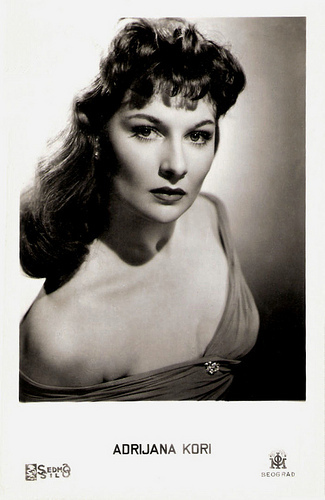
Yugoslavian postcard by IOM, Beograd. Photo: Sedmo Silo.
Beautiful Flaming Red Hair
Adrienne Corri was born as Adrienne Riccoboni in Edinburgh, Scotland, in 1931 (according to Wikipedia ; IMDb gives 1930). Her parents were Italian. She attended the Royal Academy of the Dramatic Arts (RADA) in London and then appeared on both the English and American stage. While still a teenager, she made her film debut in the comedy The Romantic Age (Edmond T. Gréville, 1949) starring a young Mai Zetterling .
Next she played Valerie, one of the three adolescent girls living in Bengal near the Ganges in The River (Jean Renoir, 1950), filmed on location in India. It was Renoir 's first colour film, and showed off Corri’s beautiful flaming red hair which would become her trademark. Martin Scorsese later called The River "one of the two most beautiful color films ever made".
For Corri it was the start of a successful film career. She appeared in many horror and suspense films, including The Kidnappers (Philip Leacock, 1953), Devil Girl from Mars (David McDonald, 1954) and Corridors of Blood (Robert Day, 1958) starring Boris Karloff.
During the 1950s she also often appeared on television, in such family series as The Three Musketeers (1954) as Milady de Winter, The Count of Monte Cristo (1956) and Sword of Freedom (1957) starring Edmund Purdom . In the early 1960s, Corri featured in several horror and action films, including The Hellfire Club (Robert S. Baker, Monty Berman, 1961) with Keith Michell and Peter Cushing, and A Study in Terror (James Hill, 1965).
In 1965 she also played supporting parts in the interesting thriller Bunny Lake Is Missing (Otto Preminger, 1965) with Carol Lynley and Laurence Olivier , and in the classic blockbuster Dr. Zhivago (1965, David Lean) as the mother of Lara ( Julie Christie ). It lead to more film roles, such as in the science fiction film Moon Zero Two (Roy Ward Baker, 1969), but she was mainly seen in numerous TV series. On stage and TV she appeared in Shakespeare’s Twelfth Night (John Sichel, 1969), as the Countess Olivia opposite Alec Guinness as Malvolio.
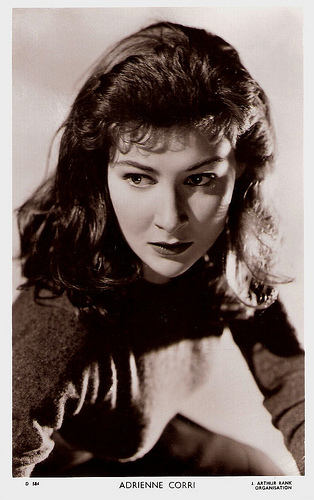
British postcard in the Picturegoer Series, London, no. D 584. Photo: J. Arthur Rank Organisation.
'Go, f**k yourselves'
One of Adrienne Corri’s most spectacular film performances was in A Clockwork Orange (Stanley Kubrick, 1971). She played Mrs. Alexander, the victim of the bizarre gang-rape by ultraviolent punk Alex DeLarge and his three droogs. Alex (Malcolm McDowell) ritually rapes her while dancing to the tune of Singing in the Rain. The scene required for her to be completely nude, and Kubrick’s continuous calls for more takes reportedly made her raging at the director.
She seemed better at ease in the stylish Hammer horror film Vampire Circus (Robert Young, 1972) in which she starred as the Gypsy Queen opposite John Moulder-Brown. During the 1970s Corri also appeared in the cinema in the thriller Rosebud (Otto Preminger, 1975) with Peter O’Toole , and as Therese Douvier in Revenge of the Pink Panther (Blake Edwards, 1978) starring Peter Sellers as Inspector Clouseau.
Corri continued to mix film and TV. Her final film appearance was in the Graham Greene adaptation The Human Factor (Otto Preminger, 1979) starring Richard Attenborough and Joop Doderer . Her later television credits include Mena in the Doctor Who story The Leisure Hive (1980) and Lady Rebecca in Lovejoy (1992).
Meanwhile, she had a major stage career. In the theatre, she specialised in fiery, flamboyant characters. The Guardian critic Michael Billington recalled on his blog a famous incident: “Adrienne Corri, on the disastrous first night of John Osborne's The World of Paul Slickey, responding to the avalanche of curtain-call booing by raising two fingers to the audience and shouting ‘Go, f**k yourselves’.”
She became a well-known expert on eighteenth-century portrait painting and published in 1985 a book about the painter Thomas Gainsborough. Adrienne Corri married and divorced the actor Daniel Massey (1961–1967). Before her marriage to Massey she had two illegitimate children. Adrienne Corri was 84.
Trailer The River (1951). Source: Plamen Plamenov (YouTube).
Trailer Devil Girl from Mars (1954). Source: John Hilarious (YouTube).
Trailer A Clockwork Orange (1971). Source: Warner Bros. Home Entertainment (YouTube).
Trailer Vampire Circus (1972). Source: Synapse Films (YouTube).
Sources: Hal Erickson (AllMovie), (IMDb), Michael Billington (Guardian Unlimited), The Times (subscription required), Wikipedia and .

Yugoslavian postcard by IOM, Beograd. Photo: Sedmo Silo.
Beautiful Flaming Red Hair
Adrienne Corri was born as Adrienne Riccoboni in Edinburgh, Scotland, in 1931 (according to Wikipedia ; IMDb gives 1930). Her parents were Italian. She attended the Royal Academy of the Dramatic Arts (RADA) in London and then appeared on both the English and American stage. While still a teenager, she made her film debut in the comedy The Romantic Age (Edmond T. Gréville, 1949) starring a young Mai Zetterling .
Next she played Valerie, one of the three adolescent girls living in Bengal near the Ganges in The River (Jean Renoir, 1950), filmed on location in India. It was Renoir 's first colour film, and showed off Corri’s beautiful flaming red hair which would become her trademark. Martin Scorsese later called The River "one of the two most beautiful color films ever made".
For Corri it was the start of a successful film career. She appeared in many horror and suspense films, including The Kidnappers (Philip Leacock, 1953), Devil Girl from Mars (David McDonald, 1954) and Corridors of Blood (Robert Day, 1958) starring Boris Karloff.
During the 1950s she also often appeared on television, in such family series as The Three Musketeers (1954) as Milady de Winter, The Count of Monte Cristo (1956) and Sword of Freedom (1957) starring Edmund Purdom . In the early 1960s, Corri featured in several horror and action films, including The Hellfire Club (Robert S. Baker, Monty Berman, 1961) with Keith Michell and Peter Cushing, and A Study in Terror (James Hill, 1965).
In 1965 she also played supporting parts in the interesting thriller Bunny Lake Is Missing (Otto Preminger, 1965) with Carol Lynley and Laurence Olivier , and in the classic blockbuster Dr. Zhivago (1965, David Lean) as the mother of Lara ( Julie Christie ). It lead to more film roles, such as in the science fiction film Moon Zero Two (Roy Ward Baker, 1969), but she was mainly seen in numerous TV series. On stage and TV she appeared in Shakespeare’s Twelfth Night (John Sichel, 1969), as the Countess Olivia opposite Alec Guinness as Malvolio.

British postcard in the Picturegoer Series, London, no. D 584. Photo: J. Arthur Rank Organisation.
'Go, f**k yourselves'
One of Adrienne Corri’s most spectacular film performances was in A Clockwork Orange (Stanley Kubrick, 1971). She played Mrs. Alexander, the victim of the bizarre gang-rape by ultraviolent punk Alex DeLarge and his three droogs. Alex (Malcolm McDowell) ritually rapes her while dancing to the tune of Singing in the Rain. The scene required for her to be completely nude, and Kubrick’s continuous calls for more takes reportedly made her raging at the director.
She seemed better at ease in the stylish Hammer horror film Vampire Circus (Robert Young, 1972) in which she starred as the Gypsy Queen opposite John Moulder-Brown. During the 1970s Corri also appeared in the cinema in the thriller Rosebud (Otto Preminger, 1975) with Peter O’Toole , and as Therese Douvier in Revenge of the Pink Panther (Blake Edwards, 1978) starring Peter Sellers as Inspector Clouseau.
Corri continued to mix film and TV. Her final film appearance was in the Graham Greene adaptation The Human Factor (Otto Preminger, 1979) starring Richard Attenborough and Joop Doderer . Her later television credits include Mena in the Doctor Who story The Leisure Hive (1980) and Lady Rebecca in Lovejoy (1992).
Meanwhile, she had a major stage career. In the theatre, she specialised in fiery, flamboyant characters. The Guardian critic Michael Billington recalled on his blog a famous incident: “Adrienne Corri, on the disastrous first night of John Osborne's The World of Paul Slickey, responding to the avalanche of curtain-call booing by raising two fingers to the audience and shouting ‘Go, f**k yourselves’.”
She became a well-known expert on eighteenth-century portrait painting and published in 1985 a book about the painter Thomas Gainsborough. Adrienne Corri married and divorced the actor Daniel Massey (1961–1967). Before her marriage to Massey she had two illegitimate children. Adrienne Corri was 84.
Trailer The River (1951). Source: Plamen Plamenov (YouTube).
Trailer Devil Girl from Mars (1954). Source: John Hilarious (YouTube).
Trailer A Clockwork Orange (1971). Source: Warner Bros. Home Entertainment (YouTube).
Trailer Vampire Circus (1972). Source: Synapse Films (YouTube).
Sources: Hal Erickson (AllMovie), (IMDb), Michael Billington (Guardian Unlimited), The Times (subscription required), Wikipedia and .
Published on March 27, 2016 22:00
March 26, 2016
Izolda Izvitskaya
Russian actress Izolda Izvitskaya (1932-1971) was a shining star of the Soviet cinema in the late 1950s. In 1971 she died tragically of cold and starvation, a forgotten alcoholic.
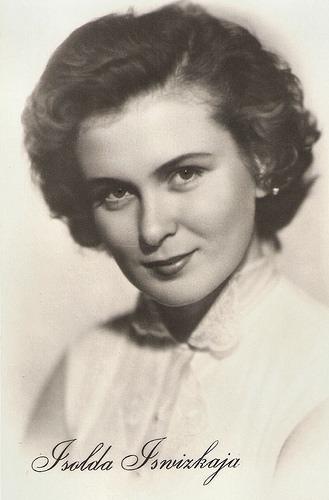
East-German postcard by VEB Progress Film-Vertrieb, Berlin, no. 519, 1957. Photo: Sovexportfilm.
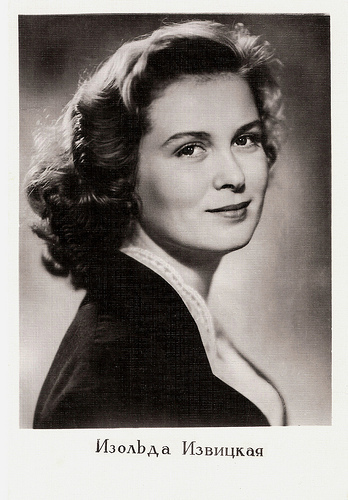
Russian postcard by Izdanije Byuro Propogandy Sovietskogo Kinoiskusstva, no. 3279. Photo: Ter-Ovanesova. The retail price was 75 kop.
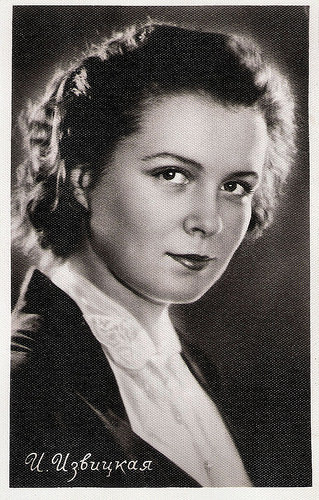
Russian postcard, no. 15, 1959.
Young Enthusiasts
Izolda Vasilyevna Izvitskaya (Russian: Изольда Васильевна Извицкая) was born in the small town of Dzerzhinsk, Soviet Union (now Nizhny Novgorod Oblast, Russia) in 1932. Her father was a chemist, her mother a teacher.
In the summer of 1950 - right after high school, she was accepted to the VGIK (All-Union State Institute of Cinematography). She was given parts in several films while still a student.
After graduating from the VGIK in 1955, the graceful Izvitskaya was chosen by director Grigori Chukhray for the lead of a wild and violent red army sharpshooter in Sorok Pervyy/The Forty-First (Grigori Chukhray, 1956) opposite popular actor Oleg Strizhenov .
At AllMovie , Hal Erickson writes: "Sorok Pervy was a typically patriotic Soviet entry in the 1957 Cannes Film Festival. The story focuses in on Isolda Izvitskaya, cast as a courageous Revolution-era female sharpshooter. While escorting a male White Russian prisoner back to her own lines, Isolda and her captive are marooned on a desert island. Predictably, a romance blossoms between the two former enemies. Unpredictably, Isolda is forced to make a daunting sacrifice to rescue her lover from punishment at the hands of the Czarists."
The film was based on the novel by Boris Lavrenyev, previously filmed in 1928 by Yakov Protazanov. The patriotic epic was very successful all over Russia. In Cannes it got the Prix spécial du jury à Cannes (the Special Jury Prize). Izolda Izvitskaya herself also got a very good reception in France. In Paris, a new cafe was even named after her, Isolde.
In her next film Pervyy eshelon/The First Echelon (Mikhail Kalatozov, 1957) she was one of a group of young enthusiasts, that arrives in a steppe district of Kazakhstan to develop the virgin land. They have to survive severe frosts, overcome spring mudflows and live in uncomfortable conditions. But finally they form an advanced collective farm and settle their private lives. At this film she worked with fer future husband, Eduard Bredun.
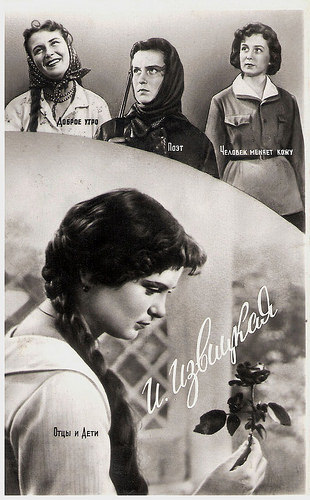
Russian postcard, no. 54, 1960.
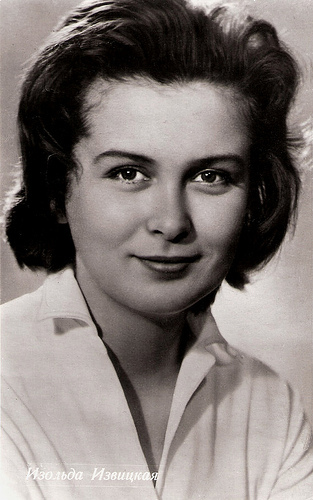
Russian postcard by Izdanije Byuro Propogandy Sovietskogo Kinoiskusstva, no. 55454, 1963. This postcard was printed in an edition of 150.000 cards. The retail price was 8 kop.
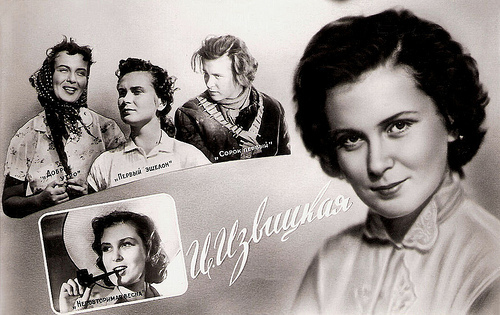
Russian postcard, no. 109, 1959. This postcard was printed in an edition of 75.000 cards.
Alcohol Problems
Izolda Izvitskaya was made a member of the Association for Cultural Relations with Latin American countries which gave her an opportunity to travel outside of the USSR. In a short time she visited Paris, Brussels, Vienna, Budapest, Warsaw, Buenos Aires and other cities.
She still had enough time to star in several more films, including Nepovtorimaya vesna/A Unique Spring (Aleksandr Stolper, 1957), Mir vkhodyashchemu/Peace to Him Who Enters (Aleksandr Alov, Vladimir Naumov, 1961) which won the Special Jury prize at the Venice Film Festival, and Po tonkomu ldu/On Thin Ice (Damir Vyatich-Berezhnykh, 1966).
However, none of them was on the level of Sorok Pervy. Izvitskaya was getting depressed. Her husband, actor Eduard Bredun, started ‘helping’ her to solve her problems with alcohol. She made several more attempts to work in films but parts were getting smaller and more scarce.
Her last film was the romance Kazhdyy vecher v odinnadtsat/Every evening after eleven (Samson Samsonov, 1969) starring Margarita Volodina and Mikhail Nozhkin. In 1971 her husband left her. She had a nervous breakdown and locked herself up in her apartment in Moscow.
In 1 March, 1971, Izvitskaya was found dead at her home in Moscow which was empty of any food. Her husband insisted that the obituary state ‘poisoning with an unknown substance’ as the cause of death but according the BBC Russian service she died of cold and starvation. Izolda Izvitskaya was only 38, when she passed away.
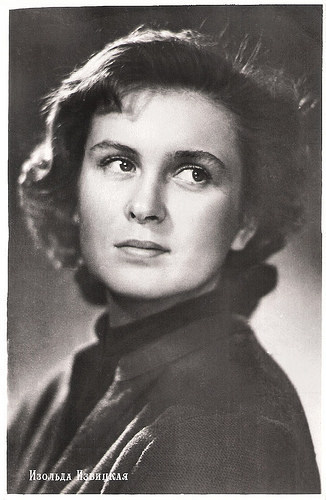
Russian postcard, no. 58817, 1958.
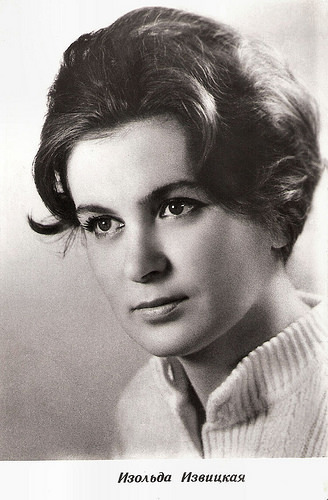
Russian postcard, no. A09767.
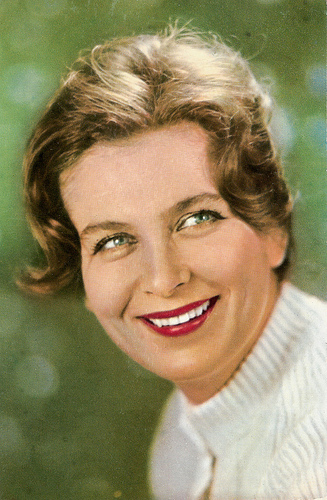
Russian postcard by Izdanije Byuro Propogandy Sovietskogo Kinoiskusstva, no. A 09465, 1965. Photo: Ter-Ovanesova. This postcard was printed in an edition of 200.000 cards. The price was 8 kop.
Sources: Hal Erickson (AllMovie), Peoples.ru (Russian), Kinoglaz.fr, Wikipedia, and .

East-German postcard by VEB Progress Film-Vertrieb, Berlin, no. 519, 1957. Photo: Sovexportfilm.

Russian postcard by Izdanije Byuro Propogandy Sovietskogo Kinoiskusstva, no. 3279. Photo: Ter-Ovanesova. The retail price was 75 kop.

Russian postcard, no. 15, 1959.
Young Enthusiasts
Izolda Vasilyevna Izvitskaya (Russian: Изольда Васильевна Извицкая) was born in the small town of Dzerzhinsk, Soviet Union (now Nizhny Novgorod Oblast, Russia) in 1932. Her father was a chemist, her mother a teacher.
In the summer of 1950 - right after high school, she was accepted to the VGIK (All-Union State Institute of Cinematography). She was given parts in several films while still a student.
After graduating from the VGIK in 1955, the graceful Izvitskaya was chosen by director Grigori Chukhray for the lead of a wild and violent red army sharpshooter in Sorok Pervyy/The Forty-First (Grigori Chukhray, 1956) opposite popular actor Oleg Strizhenov .
At AllMovie , Hal Erickson writes: "Sorok Pervy was a typically patriotic Soviet entry in the 1957 Cannes Film Festival. The story focuses in on Isolda Izvitskaya, cast as a courageous Revolution-era female sharpshooter. While escorting a male White Russian prisoner back to her own lines, Isolda and her captive are marooned on a desert island. Predictably, a romance blossoms between the two former enemies. Unpredictably, Isolda is forced to make a daunting sacrifice to rescue her lover from punishment at the hands of the Czarists."
The film was based on the novel by Boris Lavrenyev, previously filmed in 1928 by Yakov Protazanov. The patriotic epic was very successful all over Russia. In Cannes it got the Prix spécial du jury à Cannes (the Special Jury Prize). Izolda Izvitskaya herself also got a very good reception in France. In Paris, a new cafe was even named after her, Isolde.
In her next film Pervyy eshelon/The First Echelon (Mikhail Kalatozov, 1957) she was one of a group of young enthusiasts, that arrives in a steppe district of Kazakhstan to develop the virgin land. They have to survive severe frosts, overcome spring mudflows and live in uncomfortable conditions. But finally they form an advanced collective farm and settle their private lives. At this film she worked with fer future husband, Eduard Bredun.

Russian postcard, no. 54, 1960.

Russian postcard by Izdanije Byuro Propogandy Sovietskogo Kinoiskusstva, no. 55454, 1963. This postcard was printed in an edition of 150.000 cards. The retail price was 8 kop.

Russian postcard, no. 109, 1959. This postcard was printed in an edition of 75.000 cards.
Alcohol Problems
Izolda Izvitskaya was made a member of the Association for Cultural Relations with Latin American countries which gave her an opportunity to travel outside of the USSR. In a short time she visited Paris, Brussels, Vienna, Budapest, Warsaw, Buenos Aires and other cities.
She still had enough time to star in several more films, including Nepovtorimaya vesna/A Unique Spring (Aleksandr Stolper, 1957), Mir vkhodyashchemu/Peace to Him Who Enters (Aleksandr Alov, Vladimir Naumov, 1961) which won the Special Jury prize at the Venice Film Festival, and Po tonkomu ldu/On Thin Ice (Damir Vyatich-Berezhnykh, 1966).
However, none of them was on the level of Sorok Pervy. Izvitskaya was getting depressed. Her husband, actor Eduard Bredun, started ‘helping’ her to solve her problems with alcohol. She made several more attempts to work in films but parts were getting smaller and more scarce.
Her last film was the romance Kazhdyy vecher v odinnadtsat/Every evening after eleven (Samson Samsonov, 1969) starring Margarita Volodina and Mikhail Nozhkin. In 1971 her husband left her. She had a nervous breakdown and locked herself up in her apartment in Moscow.
In 1 March, 1971, Izvitskaya was found dead at her home in Moscow which was empty of any food. Her husband insisted that the obituary state ‘poisoning with an unknown substance’ as the cause of death but according the BBC Russian service she died of cold and starvation. Izolda Izvitskaya was only 38, when she passed away.

Russian postcard, no. 58817, 1958.

Russian postcard, no. A09767.

Russian postcard by Izdanije Byuro Propogandy Sovietskogo Kinoiskusstva, no. A 09465, 1965. Photo: Ter-Ovanesova. This postcard was printed in an edition of 200.000 cards. The price was 8 kop.
Sources: Hal Erickson (AllMovie), Peoples.ru (Russian), Kinoglaz.fr, Wikipedia, and .
Published on March 26, 2016 22:00
March 25, 2016
Jean-Marc Barr
Attractive French-American actor Jean-Marc Barr (1960) is best known for his roles for Lars von Trier in Europa/Zentropa (1991), Breaking the Waves (1996) and Dogville (2003).

French postcard by Editions Champs Libres, no. ST 116, 1989.
The Big Blue
Jean-Marc Barr was born in Bitburg, Germany, in 1960. His father was American and his mother French and he is fluent in both French and English. His father, working in the US Armed Forces, was stationed in West-Germany. The family moved to California in 1974.
In 1978, Barr graduated from Mission Bay High School in San Diego, California. Barr's parents wished him to join the armed forces but he was unwilling to follow in his father's footsteps. He studied philosophy at the University of California, Los Angeles, the Paris Conservatoire and the Sorbonne. He moved to London to pursue an education in drama at the Guildhall School of Music and Drama.
Barr made his film debut as Absalom in King David (Bruce Beresford, 1985) with Richard Gere. He began working in theatre in France in 1986. He soon found work in television including a small role in Hotel du Lac (1986), the BBC's version of the Booker prize-winning novel by Anita Brookner. He also appeared in the films Hope and Glory (John Boorman, 1987) and Maurice (James Ivory, 1987).
He had his breakthrough when he was cast in the tremendously successful French film Le Grand bleu/The Big Blue (Luc Besson, 1988). He played French diver Jacques Mayol, alongside Rosanna Arquette and Jean Reno. Le Grand bleu became the most financially successful film in France in the 1980s.
At IMDb , Luis Filipe dos Reis Peres tries to describe the special effect the film has on its viewers: “I never before saw a film that I could identify myself so much with. I´m lucky enough to live in a place near the sea very similar and as beautiful as those in the movie and the opening scenes always remind me of my teenage years and the waters I explored like young Jacques Mayol does in the beginning of the movie. (...) I guess that´s the beauty of this movie. It makes us feel that we could be any of its characters, because they´re so real. We almost can´t believe that they don´t exist outside of the movie. This is an amazing, beautifully well written, acted, photographed and directed movie! It carries us into an extraordinary world.”

French postcard by Ciné Passion, no. GB 7. Photo: publicity still for Le Grand Bleu (Luc Besson, 1988).
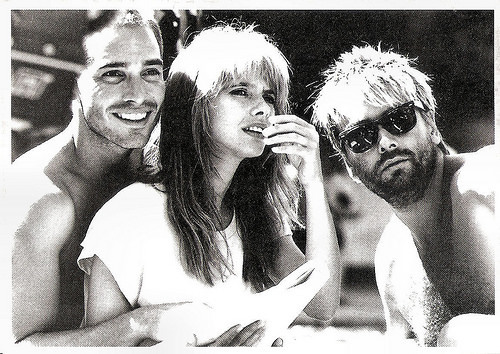
French postcard by Especially for you, Ref. 30. Photo: publicity still for Le Grand Bleu (Luc Besson, 1988). Jean-Marc Barr, Rosanna Arquette and Luc Besson on the set.
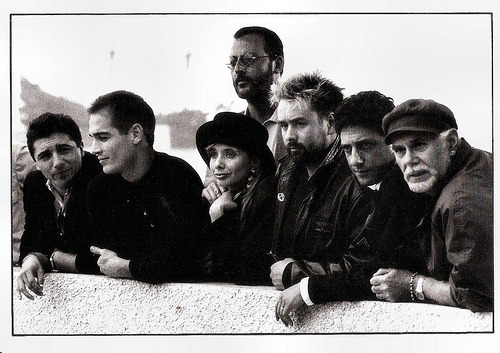
French postcard by News Productions, Beaulmes, no 56063. Photo: Eric Coiffier. Director and cast of Le Grand Bleu (Luc Besson, 1988) at the Festival de Cannes, 1988. With in the front row from left to right: Marc Duret, Jean-Marc Barr, Rosanna Arquette, Luc Besson, Sergio Castellitto and Andréas Voutsinas.
Zentropa
In 1991, Jean-Marc Barr starred opposite Barbara Sukowa and Udo Kier in Danish director Lars von Trier's Europa/Zentropa. It marked the beginning of a long friendship as well as a significant professional relationship. He went on to appear in Von Trier’s Breaking the Waves (1996) with Emily Watson, Dancer in the Dark (2000) with Björk and Catherine Deneuve , Dogville (2004), Manderlay (2005), Direktøren for det hele/The Boss of It All (2006) and both parts of Nymph()maniac (2013) with Charlotte Gainsbourg .
Jean-Marc Barr appeared as the main character in the video for Blur's single, Charmless Man (1995). Films in which he starred were The Scarlet Tunic (Stuart St. Paul, 1997) and J'aimerais pas crever un dimanche/Don't Let Me Die on a Sunday (Didier Le Pêcheur, 1999) with Élodie Bouchez.
Barr’s collaboration with Lars von Trier put him on track to start directing his own work in the Dogme95 style. He debuted as a director, screenwriter and producer with the intimate love story Lovers (1999). The film became the first part of a trilogy, together with the drama Too Much Flesh (2000) and the comedy Being Light (2001), which he both co-directed with Pascal Arnold. Barr and Arnold also directed Chacun sa nuit/One to another (2006), American Translation (2011) and Sexual Chronicles of a French Family (2012).
As an actor he appeared as Hugo in La sirène rouge/The Red Siren (Olivier Megaton, 2002) opposite Asia Argento , as divorce lawyer Maitre Bertram in the Merchant Ivory film Le Divorce (James Ivory, 2003) and as the studly, horny 'island plumber' Didier in the witty comedy Crustacés et Coquillages/Cockles & Muscles (Olivier Ducastel, Jacques Martineau, 2005).
More recently, he played Beat Generation author Jack Kerouac in the film adaptation of Kerouac’s autobiographical novel Big Sur (Michael Polish, 2013). Nathan Southern at AllMovie : “the Polish movie nails Kerouac's paradigm in its many different guises, including the exhilaration of his road cruises with his buddies, the zen of his naturalism, and his creative impotence and inner sexual death. Those assets shouldn't be underestimated, particularly in light of the many individuals over the years who have branded Kerouac's work ‘unfilmable’; Polish proves them wrong. And the lead performances are outstanding across the board. Jean-Marc Barr evokes the real Kerouac (visually and emotionally) with such approximation that we may feel we're watching a documentary.”
Jean-Marc Barr was married to Irina Decermic. He is the godfather of the children of Lars von Trier.
Trailer Le Grand Bleu/The Big Blue (1988). Source: Chaîne de adamparks55 (YouTube).
Trailer Europa/Zentropa (1991). Source: Cine Danés (YouTube).
Trailer Big Sur (2013). Source: Movieclips Film Festivals & Indie Films (YouTube).
Sources: Nathan Southern (AllMovie), Luis Filipe dos Reis Peres (IMDb), Wikipedia and .

French postcard by Editions Champs Libres, no. ST 116, 1989.
The Big Blue
Jean-Marc Barr was born in Bitburg, Germany, in 1960. His father was American and his mother French and he is fluent in both French and English. His father, working in the US Armed Forces, was stationed in West-Germany. The family moved to California in 1974.
In 1978, Barr graduated from Mission Bay High School in San Diego, California. Barr's parents wished him to join the armed forces but he was unwilling to follow in his father's footsteps. He studied philosophy at the University of California, Los Angeles, the Paris Conservatoire and the Sorbonne. He moved to London to pursue an education in drama at the Guildhall School of Music and Drama.
Barr made his film debut as Absalom in King David (Bruce Beresford, 1985) with Richard Gere. He began working in theatre in France in 1986. He soon found work in television including a small role in Hotel du Lac (1986), the BBC's version of the Booker prize-winning novel by Anita Brookner. He also appeared in the films Hope and Glory (John Boorman, 1987) and Maurice (James Ivory, 1987).
He had his breakthrough when he was cast in the tremendously successful French film Le Grand bleu/The Big Blue (Luc Besson, 1988). He played French diver Jacques Mayol, alongside Rosanna Arquette and Jean Reno. Le Grand bleu became the most financially successful film in France in the 1980s.
At IMDb , Luis Filipe dos Reis Peres tries to describe the special effect the film has on its viewers: “I never before saw a film that I could identify myself so much with. I´m lucky enough to live in a place near the sea very similar and as beautiful as those in the movie and the opening scenes always remind me of my teenage years and the waters I explored like young Jacques Mayol does in the beginning of the movie. (...) I guess that´s the beauty of this movie. It makes us feel that we could be any of its characters, because they´re so real. We almost can´t believe that they don´t exist outside of the movie. This is an amazing, beautifully well written, acted, photographed and directed movie! It carries us into an extraordinary world.”

French postcard by Ciné Passion, no. GB 7. Photo: publicity still for Le Grand Bleu (Luc Besson, 1988).

French postcard by Especially for you, Ref. 30. Photo: publicity still for Le Grand Bleu (Luc Besson, 1988). Jean-Marc Barr, Rosanna Arquette and Luc Besson on the set.

French postcard by News Productions, Beaulmes, no 56063. Photo: Eric Coiffier. Director and cast of Le Grand Bleu (Luc Besson, 1988) at the Festival de Cannes, 1988. With in the front row from left to right: Marc Duret, Jean-Marc Barr, Rosanna Arquette, Luc Besson, Sergio Castellitto and Andréas Voutsinas.
Zentropa
In 1991, Jean-Marc Barr starred opposite Barbara Sukowa and Udo Kier in Danish director Lars von Trier's Europa/Zentropa. It marked the beginning of a long friendship as well as a significant professional relationship. He went on to appear in Von Trier’s Breaking the Waves (1996) with Emily Watson, Dancer in the Dark (2000) with Björk and Catherine Deneuve , Dogville (2004), Manderlay (2005), Direktøren for det hele/The Boss of It All (2006) and both parts of Nymph()maniac (2013) with Charlotte Gainsbourg .
Jean-Marc Barr appeared as the main character in the video for Blur's single, Charmless Man (1995). Films in which he starred were The Scarlet Tunic (Stuart St. Paul, 1997) and J'aimerais pas crever un dimanche/Don't Let Me Die on a Sunday (Didier Le Pêcheur, 1999) with Élodie Bouchez.
Barr’s collaboration with Lars von Trier put him on track to start directing his own work in the Dogme95 style. He debuted as a director, screenwriter and producer with the intimate love story Lovers (1999). The film became the first part of a trilogy, together with the drama Too Much Flesh (2000) and the comedy Being Light (2001), which he both co-directed with Pascal Arnold. Barr and Arnold also directed Chacun sa nuit/One to another (2006), American Translation (2011) and Sexual Chronicles of a French Family (2012).
As an actor he appeared as Hugo in La sirène rouge/The Red Siren (Olivier Megaton, 2002) opposite Asia Argento , as divorce lawyer Maitre Bertram in the Merchant Ivory film Le Divorce (James Ivory, 2003) and as the studly, horny 'island plumber' Didier in the witty comedy Crustacés et Coquillages/Cockles & Muscles (Olivier Ducastel, Jacques Martineau, 2005).
More recently, he played Beat Generation author Jack Kerouac in the film adaptation of Kerouac’s autobiographical novel Big Sur (Michael Polish, 2013). Nathan Southern at AllMovie : “the Polish movie nails Kerouac's paradigm in its many different guises, including the exhilaration of his road cruises with his buddies, the zen of his naturalism, and his creative impotence and inner sexual death. Those assets shouldn't be underestimated, particularly in light of the many individuals over the years who have branded Kerouac's work ‘unfilmable’; Polish proves them wrong. And the lead performances are outstanding across the board. Jean-Marc Barr evokes the real Kerouac (visually and emotionally) with such approximation that we may feel we're watching a documentary.”
Jean-Marc Barr was married to Irina Decermic. He is the godfather of the children of Lars von Trier.
Trailer Le Grand Bleu/The Big Blue (1988). Source: Chaîne de adamparks55 (YouTube).
Trailer Europa/Zentropa (1991). Source: Cine Danés (YouTube).
Trailer Big Sur (2013). Source: Movieclips Film Festivals & Indie Films (YouTube).
Sources: Nathan Southern (AllMovie), Luis Filipe dos Reis Peres (IMDb), Wikipedia and .
Published on March 25, 2016 23:00
March 24, 2016
EFSP's Dazzling Dozen: Colourful Film Pictures
Ross Verlag in Berlin put out little cards known as cigarette cards, which were much smaller than the famous Ross postcards. These cards (app. 7 x 5,5 cm or 28 x 22, 5 inch) were sold in packs or cartons of cigarettes in Germany and a few other countries. One of the series was called Bunte Filmbilder (Colourful Film Pictures) of which we know two series with both Hollywood and European stars. The cards have numbers on the back and were meant to be pasted into a book. The book for the second series was published in 1936. Some pictures were duplicates of photos seen on postcards, but others were designed just for the cigarette cards, which were printed for different tobacco brands. Here are twelve of these wonderful and indeed colourful film pictures.
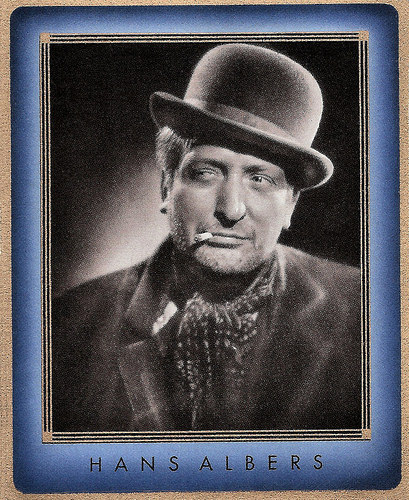
Hans Albers . German collectors card in the Bunte Filmbilder series by G. Zuban, München, no. 115. Photo: Ufa / Ross-Verlag.
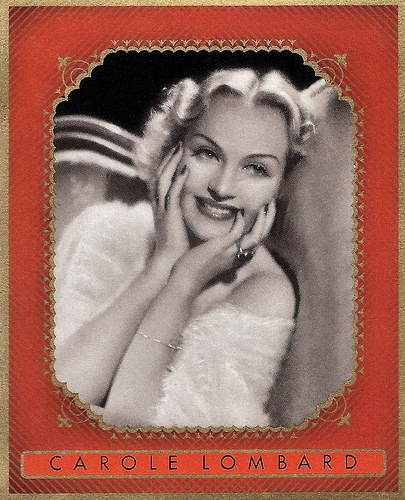
Carole Lombard. German collectors card in the Bunte Filmbilder series by Greilingen-Zigaretten, Series no. 2, no. 259. Photo: Paramount / Ross-Verlag.
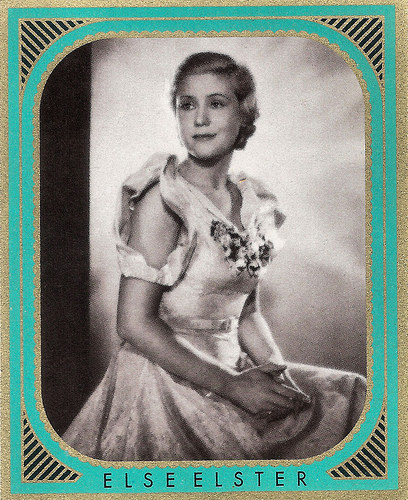
Else Elster. German collectors card in the Bunte Filmbilder series by Caid Zigaretten, Series no. 2, no. 323. Photo: Schulz and Wuellner / Ross-Verlag.
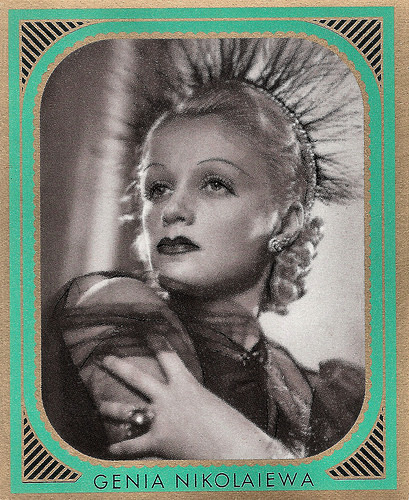
Genia Nikolaieva . German collectors card in the Bunte Filmbilder series by Greiling-Zigaretten, Series no. 2, no. 358. Photo: Ufa / Ross Verlag.
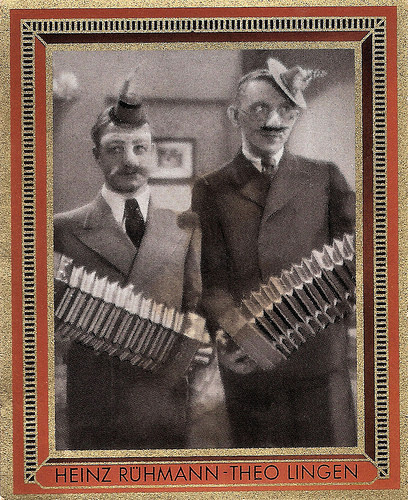
Heinz Rühmann and Theo Lingen . German collectors card in the Bunte Filmbilder series by Drama Zigaretten, Series no. 2, no. 360. Photo: Projectograph-Film / Ross-Verlag.
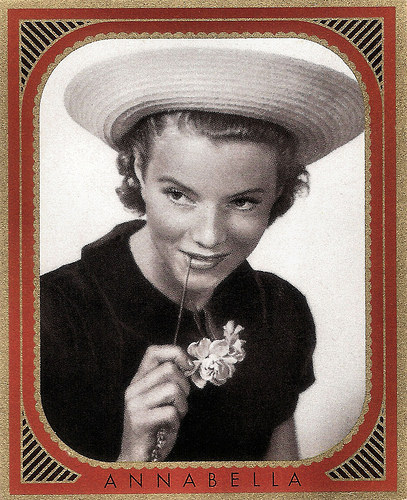
Annabella . German collectors card in the Bunte Filmbilder series by Greiling-Zigaretten, Series no. 2, no. 384. Photo: New World Pictures / Ross-Verlag.
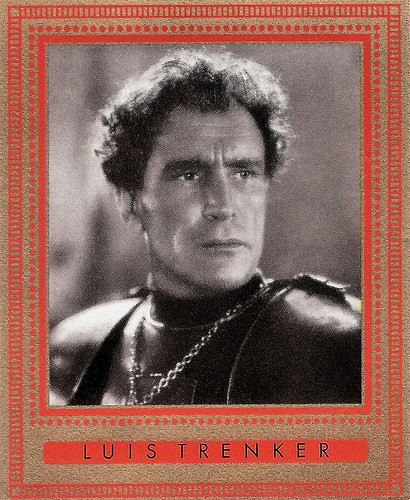
Luis Trenker . German collectors card in the Bunte Filmbilder series by Greiling Zigaretten, Series no. 2, no. 403. Photo: Trenker-Tobis-Rota / Ross-Verlag.
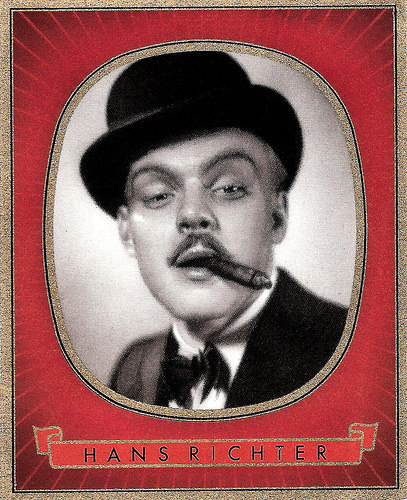
Hans Richter . German collectors card in the Bunte Filmbilder series by Drama Zigaretten, Series no. 2, no. 459. Photo: Cando-Film / Ross-Verlag.
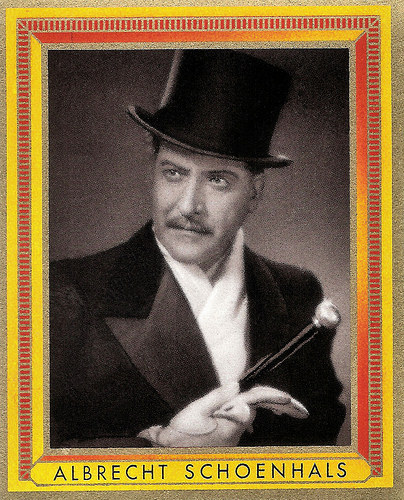
Albrecht Schoenhals . German collectors card in the Bunte Filmbilder series by Greilingen Zigaretten, Series no. 2, no. 465. Photo: Deka-Syndikat-Film / Ross-Verlag.
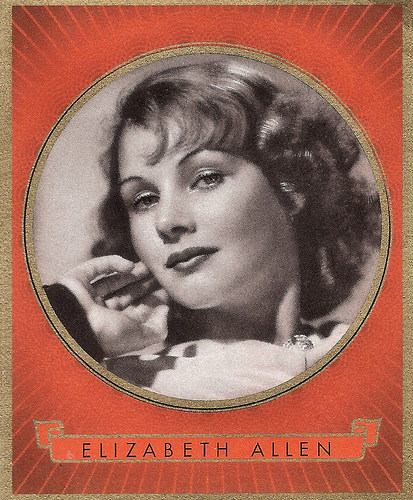
Elizabeth Allan . German collectors card in the Bunte Filmbilder series by Greiling-Zigaretten, Series no. 2, no. 484. Photo: Styria-Film / Ross-Verlag.
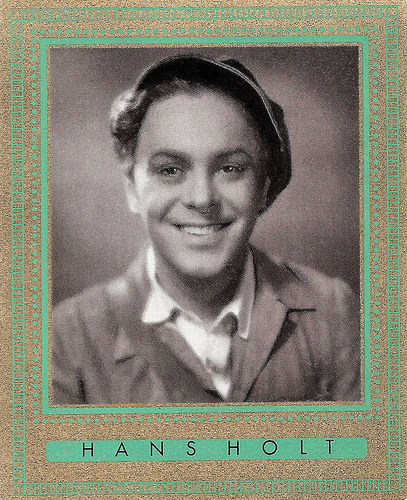
Hans Holt . German collectors card in the Bunte Filmbilder series by Caid, Series no. 2, no. 491. Photo: Styria-Film / Ross Verlag.
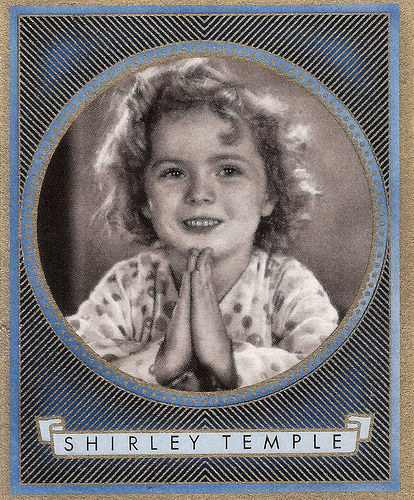
Shirley Temple. German collectors card in the Bunte Filmbilder series by Caid, Series no. 2, no. 496. Photo: Fox-Film / Ross Verlag.
Source: Mark Goffee (Ross Verlag Movie Star Postcards).
This is a post for Postcard Friendship Friday, hosted by Beth at the The Best Hearts are Crunchy. You can visit her by clicking on the button below.


Hans Albers . German collectors card in the Bunte Filmbilder series by G. Zuban, München, no. 115. Photo: Ufa / Ross-Verlag.

Carole Lombard. German collectors card in the Bunte Filmbilder series by Greilingen-Zigaretten, Series no. 2, no. 259. Photo: Paramount / Ross-Verlag.

Else Elster. German collectors card in the Bunte Filmbilder series by Caid Zigaretten, Series no. 2, no. 323. Photo: Schulz and Wuellner / Ross-Verlag.

Genia Nikolaieva . German collectors card in the Bunte Filmbilder series by Greiling-Zigaretten, Series no. 2, no. 358. Photo: Ufa / Ross Verlag.

Heinz Rühmann and Theo Lingen . German collectors card in the Bunte Filmbilder series by Drama Zigaretten, Series no. 2, no. 360. Photo: Projectograph-Film / Ross-Verlag.

Annabella . German collectors card in the Bunte Filmbilder series by Greiling-Zigaretten, Series no. 2, no. 384. Photo: New World Pictures / Ross-Verlag.

Luis Trenker . German collectors card in the Bunte Filmbilder series by Greiling Zigaretten, Series no. 2, no. 403. Photo: Trenker-Tobis-Rota / Ross-Verlag.

Hans Richter . German collectors card in the Bunte Filmbilder series by Drama Zigaretten, Series no. 2, no. 459. Photo: Cando-Film / Ross-Verlag.

Albrecht Schoenhals . German collectors card in the Bunte Filmbilder series by Greilingen Zigaretten, Series no. 2, no. 465. Photo: Deka-Syndikat-Film / Ross-Verlag.

Elizabeth Allan . German collectors card in the Bunte Filmbilder series by Greiling-Zigaretten, Series no. 2, no. 484. Photo: Styria-Film / Ross-Verlag.

Hans Holt . German collectors card in the Bunte Filmbilder series by Caid, Series no. 2, no. 491. Photo: Styria-Film / Ross Verlag.

Shirley Temple. German collectors card in the Bunte Filmbilder series by Caid, Series no. 2, no. 496. Photo: Fox-Film / Ross Verlag.
Source: Mark Goffee (Ross Verlag Movie Star Postcards).
This is a post for Postcard Friendship Friday, hosted by Beth at the The Best Hearts are Crunchy. You can visit her by clicking on the button below.

Published on March 24, 2016 23:00
March 23, 2016
Rita Gam (1927-2016)
Last Tuesday, glamorous American film and television actress Rita Gam passed away. After a promising debut in the Film Noir The Thief (Russell Rouse, 1952), her subsequent Hollywood roles were largely unrewarding. She appeared in European films and won a Silver Bear at the Berlin International Film Festival for the Sartre adaptation No Exit (1962). Gam also worked as a documentary film maker. She was 88.
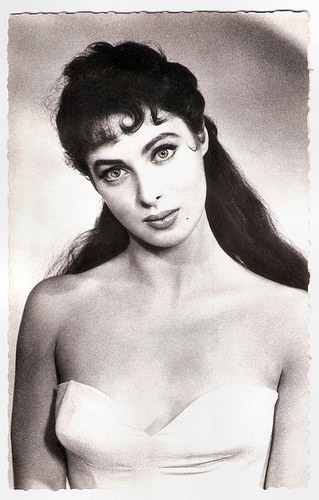
French postcard by Editions du Globe, Paris, no.479. Photo: International Press.
Grace Kelly's Bridesmaid
Rita Gam was born Rita Eleanore MacKay in Pittsburgh, Pennsylvania, in 1927. She was the daughter of Belle (Fately), a Romanian Jewish immigrant, and Milton A. MacKay. Her mother remarried in 1932. She took on the surname of her stepfather, Benjamin Gam, a Russian Jewish immigrant. Gam was raised in New York City.
Gam was a founding member of the Actor's Studio. She landed a role on Broadway in 1946 in A Flag Is Born, written by Ben Hecht. She also began to work on television, after which she moved on to films.
She first appeared in the Film Noir The Thief (Russell Rouse, 1952), which starred Ray Milland . The film is unusual because the entire story is told without dialogue. Gam was nominated for a Golden Globe as Most Promising Newcomer. Craig Butler at AllMovie : "Rouse brilliantly finds ways of telling the story without sacrificing any tension, suspense, or emotional impact. working with cinematographer Sam Leavitt, whose noir-ish camerawork is nothing short of a marvel, he shapes and tells the story in a compelling and gripping manner."
In October 1952, she signed a long-term MGM contract. She was briefly suspended from working in October 1953 for turning down the feminine lead in the Dean Martin-Jerry Lewis comedy Living It Up (Norman Taurog, 1954). The part went to Janet Leigh.
Another interesting Film Noir was Night People (Nunnally Johnson, 1954). The story is set in Berlin during the years following World War II. Gregory Peck plays a counter-intelligence officer of the United States Army. That years she also appeared in Sign of the Pagan (Douglas Sirk, 1954) about Attila the Hun (Jack Palance) and his invasion of Rome.
In 1956, she was a bridesmaid at her good friend Grace Kelly's wedding to Prince Rainier of Monaco. Soon after Gam and Kelly had signed contracts with MGM, they roomed together with another girl in a one-bedroom apartment in Hollywood. They remained close until Kelly's death in 1982.
In Italy she starred opposite Alberto Sordi in the comedy Costa Azzurra/Wild Cats on the Beach (Vittorio Sala, 1959) and she was the leading lady of the Peplum Annibale/Hannibal (Carlo Ludovico Bragaglia, Edgar G. Ulmer, 1959) featuring Victor Mature. Despite being an Italian production the latter was mainly financed by American studio Warner Brothers.
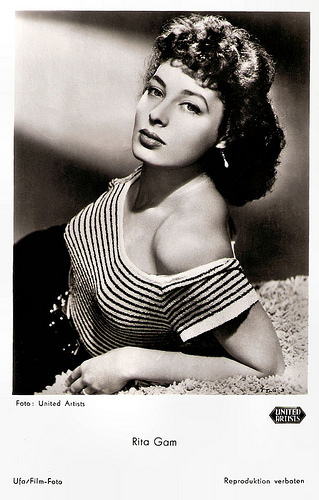
German postcard by Ufa, Berlin-Tempelhof, no. FK 672. Photo: United Artists. Publicity still for The Thief (Russell Rouse, 1952).
Trapped like rats in a cage
Rita Gam played Herodias in the biblical epic film King of Kings (Nicholas Ray, 1961) about the life of Christ (Jeffrey Hunter), from his birth and ministry to his crucifixion and resurrection.
Gam shared the Silver Bear for Best Actress award with Viveca Lindfors at the 1962 Berlin Film Festival, for their performances in No Exit (Tad Danielewski, Orson Welles (uncredited), 1962), based on the play Huis Clos by Jean-Paul Sartre. The story is about three people locked in a room: a journalist who betrayed members of the resistance movement in World War II (Morgan Sterne), a lesbian who tempted a married woman to leave her husband (Lindfors), and a social-climber (Gam) who killed her son and drove her husband to suicide. They quickly discover there is literally no exit in the room: they are trapped like rats in a cage, dead and in hell.
In 1963, Gam became a leading member of The Minnesota Theatre Company in the opening season of The Tyrone Guthrie Theater in Minneapolis, with Zoe Caldwell, Hume Cronyn and Jessica Tandy.
Later she appeared in small parts in films like the acclaimed crime thriller Klute (Alan J. Pakula, 1971), before taking up documentary film making. She produced the documentary series World of Film, which examined the film business around the world, and the PBS travel series World of Beauty.
Her final film appearance was in the Canadian-Japanese sports drama Rowing Through (Masato Harada, 1996). In 2003, she was in the rotating cast of the off-Broadway stage reading of Wit & Wisdom. Among her other notable stage productions were Hamlet with Dan Mason and Broadway's There’s a Girl in My Soup with Gig Young.
Rita Gam died of respiratory failure at Cedars-Sinai Medical Center in Los Angeles. She was married from 1949 till 1954 to director Sidney Lumet and from 1956 to 1963 to Thomas Henry Guinzburg, Jr., the first managing editor of The Paris Review and president of Viking Press. Survivors include her daughter, film producer Kate Guinzburg, her son, novelist Michael Guinzburg; and granddaughters Michelle, Olivia and Louisa.
Trailer for Annibale/Hannibal (Carlo Ludovico Bragaglia, Edgar G. Ulmer, 1959). Source: PickOfTheFlicks Tony (YouTube).
Sources: Mike Barnes (The Hollywood Reporter), Hal Erickson (AllMovie), Craig Butler (AllMovie), Wikipedia and .

French postcard by Editions du Globe, Paris, no.479. Photo: International Press.
Grace Kelly's Bridesmaid
Rita Gam was born Rita Eleanore MacKay in Pittsburgh, Pennsylvania, in 1927. She was the daughter of Belle (Fately), a Romanian Jewish immigrant, and Milton A. MacKay. Her mother remarried in 1932. She took on the surname of her stepfather, Benjamin Gam, a Russian Jewish immigrant. Gam was raised in New York City.
Gam was a founding member of the Actor's Studio. She landed a role on Broadway in 1946 in A Flag Is Born, written by Ben Hecht. She also began to work on television, after which she moved on to films.
She first appeared in the Film Noir The Thief (Russell Rouse, 1952), which starred Ray Milland . The film is unusual because the entire story is told without dialogue. Gam was nominated for a Golden Globe as Most Promising Newcomer. Craig Butler at AllMovie : "Rouse brilliantly finds ways of telling the story without sacrificing any tension, suspense, or emotional impact. working with cinematographer Sam Leavitt, whose noir-ish camerawork is nothing short of a marvel, he shapes and tells the story in a compelling and gripping manner."
In October 1952, she signed a long-term MGM contract. She was briefly suspended from working in October 1953 for turning down the feminine lead in the Dean Martin-Jerry Lewis comedy Living It Up (Norman Taurog, 1954). The part went to Janet Leigh.
Another interesting Film Noir was Night People (Nunnally Johnson, 1954). The story is set in Berlin during the years following World War II. Gregory Peck plays a counter-intelligence officer of the United States Army. That years she also appeared in Sign of the Pagan (Douglas Sirk, 1954) about Attila the Hun (Jack Palance) and his invasion of Rome.
In 1956, she was a bridesmaid at her good friend Grace Kelly's wedding to Prince Rainier of Monaco. Soon after Gam and Kelly had signed contracts with MGM, they roomed together with another girl in a one-bedroom apartment in Hollywood. They remained close until Kelly's death in 1982.
In Italy she starred opposite Alberto Sordi in the comedy Costa Azzurra/Wild Cats on the Beach (Vittorio Sala, 1959) and she was the leading lady of the Peplum Annibale/Hannibal (Carlo Ludovico Bragaglia, Edgar G. Ulmer, 1959) featuring Victor Mature. Despite being an Italian production the latter was mainly financed by American studio Warner Brothers.

German postcard by Ufa, Berlin-Tempelhof, no. FK 672. Photo: United Artists. Publicity still for The Thief (Russell Rouse, 1952).
Trapped like rats in a cage
Rita Gam played Herodias in the biblical epic film King of Kings (Nicholas Ray, 1961) about the life of Christ (Jeffrey Hunter), from his birth and ministry to his crucifixion and resurrection.
Gam shared the Silver Bear for Best Actress award with Viveca Lindfors at the 1962 Berlin Film Festival, for their performances in No Exit (Tad Danielewski, Orson Welles (uncredited), 1962), based on the play Huis Clos by Jean-Paul Sartre. The story is about three people locked in a room: a journalist who betrayed members of the resistance movement in World War II (Morgan Sterne), a lesbian who tempted a married woman to leave her husband (Lindfors), and a social-climber (Gam) who killed her son and drove her husband to suicide. They quickly discover there is literally no exit in the room: they are trapped like rats in a cage, dead and in hell.
In 1963, Gam became a leading member of The Minnesota Theatre Company in the opening season of The Tyrone Guthrie Theater in Minneapolis, with Zoe Caldwell, Hume Cronyn and Jessica Tandy.
Later she appeared in small parts in films like the acclaimed crime thriller Klute (Alan J. Pakula, 1971), before taking up documentary film making. She produced the documentary series World of Film, which examined the film business around the world, and the PBS travel series World of Beauty.
Her final film appearance was in the Canadian-Japanese sports drama Rowing Through (Masato Harada, 1996). In 2003, she was in the rotating cast of the off-Broadway stage reading of Wit & Wisdom. Among her other notable stage productions were Hamlet with Dan Mason and Broadway's There’s a Girl in My Soup with Gig Young.
Rita Gam died of respiratory failure at Cedars-Sinai Medical Center in Los Angeles. She was married from 1949 till 1954 to director Sidney Lumet and from 1956 to 1963 to Thomas Henry Guinzburg, Jr., the first managing editor of The Paris Review and president of Viking Press. Survivors include her daughter, film producer Kate Guinzburg, her son, novelist Michael Guinzburg; and granddaughters Michelle, Olivia and Louisa.
Trailer for Annibale/Hannibal (Carlo Ludovico Bragaglia, Edgar G. Ulmer, 1959). Source: PickOfTheFlicks Tony (YouTube).
Sources: Mike Barnes (The Hollywood Reporter), Hal Erickson (AllMovie), Craig Butler (AllMovie), Wikipedia and .
Published on March 23, 2016 23:00
Paul van Yperen's Blog
- Paul van Yperen's profile
- 13 followers
Paul van Yperen isn't a Goodreads Author
(yet),
but they
do have a blog,
so here are some recent posts imported from
their feed.



